Contents
Users Manual 1
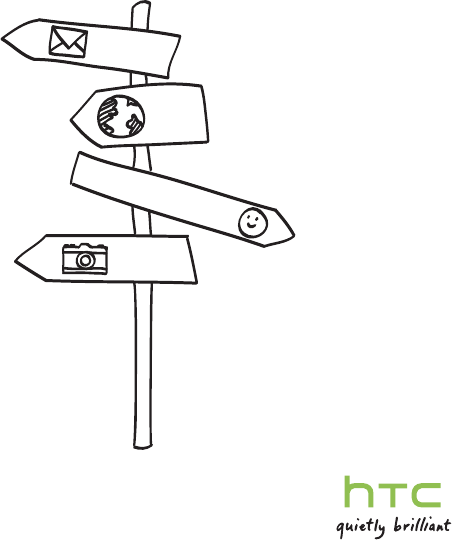
User guide

2
Before you do anything else, please read this
Charge the battery
The battery in your phone hasn’t been charged yet. While your phone
is charging, it’s important that you do not remove the battery pack.
Doing so can damage your phone. Also, please don’t try to take your
Also, please don’t try to take your phone apart. (If you do, it may
invalidate your warranty.)
Know about privacy laws
Some countries have strict laws about how and when you can record
phone conversations. For example, you may need to tell the person
you’re speaking to before you start recording. It’s a good idea to find
out what the laws are where you live before you use your phone’s
recording feature.
And finally, a few important words from our legal team
(LIMITATION OF DAMAGES)
To the maximum extent permitted by applicable law, in no event
shall HTC or its affiliates be liable to you, any user, or third party for
any indirect, special, consequential, incidental or punitive damages
of any kind, arising in contract, tort, or otherwise, including, but not
limited to, injury, loss of revenue, loss of goodwill, loss of business
opportunity, loss of data, and/or loss of profits, regardless of the
foreseeability thereof or whether HTC or its affiliates have been
advised of the possibility of such damages. And in no event shall the
total liability of HTC or its affiliates exceed the amount received from
you, regardless of the legal theory under which the cause of action is
3
brought. The foregoing does not affect any statutory rights which may
not be disclaimed.
Notice
Screen images and icons are simulated. Actual display may vary.
Instructions in this guide may change depending on the software
version on your wireless device.

4
Trademarks and copyrights
Copyright © 2011 HTC Corporation. All Rights Reserved.
The HTC logo, HTC quietly brilliant logo, HTC Sense, and any other
HTC trademarks, tradenames, logos, service marks and images are the
trademarks of HTC Corporation. All other trademarks and logos are
the property of their respective owners and used under license.
Copyright © 2011 Google Inc. Used with permission.
Google, the Google logo, Android, Google Search, Gmail, YouTube,
Android Market, Google Maps and Google Talk are trademarks of
Google Inc.
Google and the Google logo are trademarks of Google, Inc.
Microsoft, Windows, Windows XP, Windows Vista, Active Sync, and
Outlook are either registered trademarks or trademarks of Microsoft
Corporation in the United States and/or other countries.
Bluetooth and the Bluetooth logo are trademarks owned by Bluetooth
SIG, Inc.
Wi-Fi is a registered trademark of the Wireless Fidelity Alliance, Inc.
microSD is a trademark of SD Card Association.
Facebook is a trademark of Facebook, Inc.
Twitter is a trademark of Twitter, Inc., and is used under license.
Flickr is a trademark of Yahoo! Inc.
All other company, product and service names mentioned herein are
trademarks, registered trademarks or service marks of their respective
owners.

5
HTC shall not be liable for technical or editorial errors or omissions
contained herein, nor for incidental or consequential damages
resulting from furnishing this material. The information is provided
“as is” without warranty of any kind and is subject to change without
notice. HTC also reserves the right to revise the content of this
document at any time without prior notice.
No part of this document may be reproduced or transmitted in
any form or by any means, electronic or mechanical, including
photocopying, recording or storing in a retrieval system, or translated
into any language in any form without prior written permission of HTC.
Conventions used in this guide
In this user guide, we use the following symbols to indicate useful and
important information:
This is a note. A note often gives additional information, such as what
happens on your phone when you choose to do or not to do a certain
action. A note also provides information that may only be applicable to
some situations.
This is a tip. A tip gives you an alternative way to do a particular step or
procedure, or lets you know of an option that you may find helpful.
This indicates that something is very important. Important information is
something that you need to do in order to accomplish a certain task or to
get a phone feature to work properly.
This provides safety precaution information, that is, information that you
need to be careful about to prevent potential problems when using your
phone.

6
IMPORTANT CUSTOMER INFORMATION
Please be advised that many services and applications offered
through this unique device are provided by various device, operating
system, software and application developers (e.g. Google, Motorola,
Microsoft, Palm, Research In Motion). If you use, link to or download
such a service, or an application such as a non-Verizon Wireless
location based GPS-type service, chat room, marketplace or social
network from this device, you should carefully review the terms
of such service or application. If you use any of these non-Verizon
Wireless services or applications, personal information you submit
may be read, collected, or used by the service or application provider
and/or other users of those forums.
Verizon Wireless is not responsible for your use of those applications
or information you choose to submit or share with others. Specific
terms and conditions, terms of use, and privacy policies apply to those
applications and services. Please review carefully any and all terms
and conditions applicable to those applications and services including
those related to any location-based services for any particular privacy
policies, risks or waivers.
Your Verizon Wireless Customer Agreement Terms and Conditions
and certain other specifically identified terms govern your use of any
Verizon Wireless products and services.

7
Contents
Basics 21
Inside the box .......................................................................................................................21
Front panel ................................................................................................................22
Back panel ..................................................................................................................24
Top panel ....................................................................................................................25
Bottom panel ............................................................................................................25
Left and right panels .............................................................................................26
Before turning on your phone ....................................................................................27
Back cover .................................................................................................................27
Battery .........................................................................................................................28
Getting started ....................................................................................................................31
Turning on your phone..........................................................................................31
Turning off your phone .........................................................................................31
Setting up your phone for the first time .....................................................32
Home screen ....................................................................................................................... 34
Extended Home screen ...................................................................................... 34
Navigating the Home screen ............................................................................35
Going around the screen with finger gestures ........................................35
Phone status and notifications ...................................................................................37
Phone status icons .................................................................................................37
Notification icons ....................................................................................................38
Checking notifications..........................................................................................39
Adjusting the volume .....................................................................................................40
Adjusting the ringer volume.............................................................................40
Adjusting the media volume ............................................................................ 40
Sleep mode ...........................................................................................................................41
Connecting your phone to a computer ..................................................................42
8
Copying files to and from the storage card ........................................................ 45
Replacing the storage card .............................................................................. 46
Removing the storage card while the phone is on ............................... 46
Searching your phone and the Web ........................................................................47
Personalizing 49
Making your phone truly yours .................................................................................. 49
Changing the ringtone ................................................................................................... 49
Personalizing your phone with scenes .................................................................. 50
Using a preset scene ............................................................................................ 50
Customizing and saving a scene ......................................................................51
Renaming or deleting a scene ..........................................................................52
Changing your wallpaper ..............................................................................................52
Personalizing your Home screen with widgets ..................................................53
Adding a widget to your Home screen .......................................................53
Downloading HTC widgets ............................................................................... 54
Adding application icons and other shortcuts on your Home screen ....55
Adding folders on your Home screen .....................................................................56
Creating a new folder and adding items to it ...........................................56
Renaming a folder ..................................................................................................57
Rearranging or removing widgets and icons on your Home screen .......57
Moving a widget or icon .....................................................................................57
Removing a widget or icon ...............................................................................58
Phone calls 59
Making calls ..........................................................................................................................59
Calling somebody using your phone ...........................................................59
Making international calls ..................................................................................60
Calling a speed dial number ............................................................................. 60
Calling using Voice Dialer ....................................................................................61
Calling a phone number in a text message ................................................61
9
Calling a phone number in an email ..............................................................62
Making an emergency call ..................................................................................62
Using Assisted Dialing ..........................................................................................63
Receiving calls ................................................................................................................... 64
Answering an incoming call ............................................................................. 64
Rejecting an incoming call .................................................................................65
Rejecting a call and sending a text message ............................................65
Using in-call options ....................................................................................................... 66
Handling multiple calls .........................................................................................67
Setting up a three-way conference call .......................................................67
Muting the microphone during a call ........................................................... 68
Turning the speakerphone on or off during a call ................................. 68
Ending a call ........................................................................................................... 68
Using call history .............................................................................................................. 69
Adding a new phone number to your contacts from call history . 70
Checking a missed call ........................................................................................ 70
Clearing the call history list ................................................................................71
Global Phone ........................................................................................................................71
Inserting a SIM card ................................................................................................71
Calling from outside of the U.S. .......................................................................72
Changing the network your phone connects to .....................................72
Call services..........................................................................................................................73
Turning Airplane mode on or off ..............................................................................75
People 76
About People ......................................................................................................................76
Ways of getting contacts into your phone ...........................................................76
People screen ......................................................................................................................77
Setting up My contact card ...............................................................................78
Your contacts list ....................................................................................................78
Adding a new contact ......................................................................................... 80
10
Importing contacts from an Exchange ActiveSync account ........... 80
Merging contact information .............................................................................81
Editing a contact’s information .......................................................................82
Searching for a contact .......................................................................................82
Backing up your contacts to the storage card ........................................82
Importing contacts from the storage card ................................................83
Deleting contacts ...................................................................................................83
Sending contact information as a vCard via MMS .................................83
Sending your contact information as a vCard via MMS ..................... 84
Contact groups ................................................................................................................. 84
Creating a group and adding contacts ....................................................... 84
Deleting a group .....................................................................................................85
Adding or removing contacts from a group .............................................85
Sending an SMS/MMS message or email to a group ........................... 86
Contact information and conversations ................................................................ 86
People widget .................................................................................................................... 88
Adding the People widget ................................................................................ 88
Setting the default communication method ............................................ 88
Changing the default communication method ....................................... 88
Getting in touch with a contact ..................................................................... 89
Keyboard 90
Using the slide-out keyboard ..................................................................................... 90
Using the Shortcut key ........................................................................................92
Opening applications with the keyboard....................................................92
Using the onscreen keyboard .....................................................................................93
Using the landscape onscreen keyboard ....................................................93
Changing the onscreen keyboard layout ................................................... 94
Changing the keyboard language ................................................................. 94
Entering text .............................................................................................................95
Entering words with predictive text ............................................................. 96
11
Adjusting touch input settings .................................................................................. 98
Touch Input settings............................................................................................. 98
Text input ................................................................................................................... 99
Messages 101
About Messages ...............................................................................................................101
Sending text and multimedia messages ...................................................102
New message notifications ........................................................................................106
Viewing push messages ...............................................................................................107
Managing message conversations ..........................................................................108
Protecting a message from deletion ............................................................110
Deleting a message thread ............................................................................... 110
Deleting several message threads.................................................................110
Deleting a single message ..................................................................................111
Viewing contact details and communicating with a contact ............111
Setting text and multimedia message options ....................................................111
Adding the Messages widget ..................................................................................... 114
Social 115
Facebook for HTC Sense and Facebook for Android application ........... 115
Facebook for HTC Sense ................................................................................... 115
Facebook for Android application ................................................................ 116
Differences between Facebook for HTC Sense and Facebook for
Android application ...............................................................................................117
Tweeting on your phone ............................................................................................... 118
Peep screen .............................................................................................................. 118
Sending a tweet ..................................................................................................... 119
Searching for Twitter users to follow ..........................................................120
Sending a direct message ................................................................................120
Setting Peep options ........................................................................................... 121
Adding the Twitter widget ............................................................................... 122
Twitter
for HTC Sense .......................................................................................... 122
12
Using Friend Stream ...................................................................................................... 122
Friend Stream screen ......................................................................................... 123
Updating your status .......................................................................................... 124
Adding the Friend Stream widget ............................................................... 124
Chatting in Google Talk ................................................................................................ 125
Signing in to Google Talk .................................................................................. 125
Chatting with friends .......................................................................................... 125
Changing your online status and picture .................................................. 127
Managing your Friends list ............................................................................... 128
Changing Google Talk settings ......................................................................130
Accounts and sync 132
Synchronizing with online accounts ...................................................................... 132
Adding a social network account ................................................................. 133
Synchronizing with a Google Account ...................................................... 133
Synchronizing with a Microsoft Exchange ActiveSync account ... 134
Managing your accounts ...................................................................................134
Synchronizing with your computer ........................................................................ 136
Installing HTC Sync that came with the microSD card ...................... 137
Setting up HTC Sync to recognize your phone .....................................138
Getting to know the Device panel................................................................ 138
Setting up synchronization .............................................................................. 139
Synchronizing your phone ...............................................................................143
Installing apps from your computer to your phone ............................144
Synchronizing another phone with your computer ............................145
Email 146
Using Gmail .......................................................................................................................146
Viewing your Gmail inbox .................................................................................146
Reading your messages ....................................................................................148
Sending a message ............................................................................................... 151
13
Managing conversations and messages .................................................... 153
Changing Gmail settings ................................................................................... 156
Using Mail ............................................................................................................................ 157
Adding a POP3/IMAP email account .......................................................... 157
Viewing your email inbox ................................................................................. 158
Exchange ActiveSync email ............................................................................. 161
Composing and sending an email message ............................................ 162
Viewing and replying to an email message .............................................164
Editing email account settings.......................................................................164
Deleting an email account ................................................................................165
Adding the Mail widget ..................................................................................... 165
Calendar 166
About Calendar ................................................................................................................166
Creating a calendar event ........................................................................................... 167
Inviting guests to your event (Google Account only) ........................168
Sending a meeting request using Calendar (Exchange ActiveSync
only) ............................................................................................................................169
Changing calendar views ............................................................................................169
Month view ..............................................................................................................170
Day and Agenda views ....................................................................................... 171
Week view ................................................................................................................ 172
Viewing, editing or deleting an event .................................................................... 173
Viewing and editing an event ......................................................................... 173
Deleting an event .................................................................................................. 174
Calendar event reminders ........................................................................................... 174
Viewing, dismissing, or snoozing event reminders .............................. 174
Displaying and synchronizing calendars.............................................................. 175
Showing or hiding calendars .......................................................................... 175
Choosing which Google Calendars are synchronized on your
phone.......................................................................................................................... 175
14
Changing Calendar settings ....................................................................................... 176
Reminder settings ................................................................................................ 176
Calendar view settings ....................................................................................... 177
Sending a vCalendar ...................................................................................................... 178
About the Calendar widget ........................................................................................ 179
Clock and Weather 180
About the HTC Clock widget ....................................................................................180
About the Clock application ....................................................................................... 181
Using Desk Clock ............................................................................................................. 182
Using World Clock ................................................................................................... 184
Setting your home city ......................................................................................184
Setting the time zone, date, and time ....................................................185
Adding a city to the World Clock screen..................................................186
Setting the alarm clock ................................................................................................186
Setting an alarm .................................................................................................... 187
Deleting an alarm ................................................................................................. 187
Changing alarm sound settings .....................................................................188
Checking weather ...........................................................................................................189
Adding a city to the Weather screen ..........................................................190
Changing the order of cities on the Weather screen........................... 191
Deleting cities from the Weather screen ................................................... 191
Changing weather options................................................................................ 191
About the Weather widget ........................................................................................ 192
Internet 193
Data connection ...............................................................................................................193
Turning the data connection on or off ....................................................... 193
Enabling data roaming .......................................................................................193
Selecting the network to connect to when roaming ..........................194
15
Wi-Fi 194
Turning Wi-Fi on and connecting to a wireless network .................. 195
Connecting to a Wi-Fi network with EAP-TLS security ....................196
Checking the wireless network status ........................................................196
Connecting to another Wi-Fi network ....................................................... 197
Adding the mobile connection and Wi-Fi widgets......................................... 197
Connecting to a virtual private network (VPN) ...............................................198
Preparing your phone for VPN connection .............................................198
Adding a VPN connection................................................................................199
Connecting to a VPN ..........................................................................................199
Disconnecting from a VPN ..............................................................................199
Using your phone’s web browser .......................................................................... 200
Opening the browser ........................................................................................ 200
Going to a web page ........................................................................................ 200
Setting your home page ................................................................................. 200
Changing the screen orientation ..................................................................201
Browsing full versions of all web sites ........................................................201
Navigating on a web page ...............................................................................201
Zooming in or out on a web page...............................................................202
Selecting a link in a web page .......................................................................202
Opening a new browser window .................................................................203
Switching between browser windows ......................................................203
Finding text within a web page ................................................................... 204
Downloading applications from the web .................................................205
Copying text, looking up information, and sharing ............................205
Viewing bookmarks and previously visited pages ..............................208
Setting browser options ...................................................................................209
Wi-Fi Hotspot ....................................................................................................................210
16
Bluetooth 211
Using Bluetooth ................................................................................................................ 211
Turning Bluetooth on or off ............................................................................. 212
Changing the phone name .............................................................................. 212
Connecting a Bluetooth headset or car kit ........................................................ 212
Reconnecting a headset or car kit ............................................................... 213
Disconnecting or unpairing from a Bluetooth device ...................................214
Disconnecting a Bluetooth device ............................................................... 214
Unpairing from a Bluetooth device..............................................................214
Sending and receiving information using Bluetooth ..................................... 215
Sending information from your phone to another device ................ 215
Receiving information from another device ............................................ 217
Camera 219
Camera basics ................................................................................................................... 219
Viewfinder screen ................................................................................................. 219
Review screen ........................................................................................................ 221
Zooming .............................................................................................................................. 222
Taking a photo ................................................................................................................. 223
Face detection ...................................................................................................... 225
Capturing a video ................................................................................................ 225
Camera settings .............................................................................................................. 226
Changing basic settings ................................................................................... 227
Changing advanced settings ......................................................................... 227
Gallery 231
About the Gallery application ................................................................................... 231
Selecting an album ......................................................................................................... 231
Viewing photos and videos ....................................................................................... 233
Browsing in filmstrip or grid view ................................................................233
17
Viewing a photo in landscape orientation...............................................234
Zooming in or out on a photo ....................................................................... 235
Watching video ..................................................................................................... 235
Viewing photos in your social networks .............................................................236
Viewing photos on Facebook ........................................................................236
Viewing photos on Flickr .................................................................................236
Working with photos .................................................................................................... 237
Rotating and saving a photo ......................................................................... 237
Cropping a photo ................................................................................................ 237
Sharing.................................................................................................................................239
Sending photos or videos by email ............................................................239
Sending a photo or video by MMS..............................................................239
Sending photos or videos using Bluetooth ............................................240
Sharing photos on Facebook ........................................................................240
Sharing photos on Flickr ................................................................................... 241
Sharing photos on Picasa ................................................................................. 241
Sharing videos on YouTube ............................................................................ 242
Music 252
About the Music application ..................................................................................... 252
Playing music ................................................................................................................... 252
Browsing music in the Library .................................................................................254
Creating a playlist ........................................................................................................... 255
Playing the songs in a playlist ....................................................................... 255
Managing playlists ...............................................................................................256
Setting a song as ringtone ......................................................................................... 257
Checking if the song was added as a ringtone .................................... 257
Sending music using Bluetooth .............................................................................. 258
About the Music widget .............................................................................................258
18
Maps and location 259
Turning on location services .....................................................................................259
Using Google Maps ....................................................................................................... 259
About Google Maps ...........................................................................................259
Getting around maps .........................................................................................260
Searching for a location .................................................................................... 261
Searching for a place of interest near you ..............................................263
Adding a place to search .................................................................................263
Getting directions ................................................................................................264
Finding your friends with Google Latitude (available by country) .....
265
Using HTC Footprints ............................................................................................ 266
Adding a location as a footprint ..................................................................266
Revisiting a footprint ......................................................................................... 267
Editing or deleting a footprint ...................................................................... 267
Sharing your footprints .................................................................................... 267
Deleting multiple footprints ........................................................................... 267
Exporting your footprints ................................................................................ 267
Importing footprints ...........................................................................................268
More apps 269
Watching videos on YouTube ...................................................................................269
Watching videos ..................................................................................................269
Searching for videos ..........................................................................................270
Sharing a video link ...........................................................................................270
Capturing a video and sharing it on YouTube ........................................ 271
Viewing a PDF................................................................................................................... 271
Viewing documents, presentations, and spreadsheets ............................... 272
Keeping track of your stocks .................................................................................... 274
Adding a stock quote or stock market index ........................................ 275
19
Changing the stock list order ....................................................................... 275
Deleting stock quotes and indices .............................................................. 275
Setting stock information update frequency ......................................... 276
Manually updating stock information ........................................................ 276
Adding the Stocks widget .............................................................................. 276
Listening to the radio ................................................................................................... 277
Listening to an FM station ............................................................................... 278
Adding station names ....................................................................................... 278
Minimizing or turning off FM Radio ............................................................ 279
Adding the FM Radio widget ........................................................................ 279
Recording your voice ................................................................................................... 279
Recording your voice ......................................................................................... 279
Sharing a voice clip .............................................................................................280
Setting a voice clip as a ringtone ................................................................280
Renaming a voice clip .......................................................................................280
Using Flashlight ................................................................................................................ 281
Finding and installing apps from Android Market .......................................... 282
Finding and installing an application ......................................................... 282
Creating a Google Checkout account .......................................................284
Opening an installed application .................................................................284
Uninstalling an application ..............................................................................285
Getting help ............................................................................................................285
Sharing games and applications .............................................................................286
Security 288
Protecting your phone with a screen lock .........................................................288
Setting a screen unlock pattern ...................................................................288
Setting a numeric PIN .......................................................................................289
Setting a password .............................................................................................289
20
Settings 290
Settings on your phone ...............................................................................................290
Changing display settings ..........................................................................................293
Adjusting the screen brightness manually ..............................................293
Adjusting the time before the screen turns off ....................................293
Preventing automatic screen rotation .......................................................294
Recalibrating the G-sensor .............................................................................294
Switching animation effects on or off .......................................................294
Keeping the screen on while charging the phone ...............................295
Changing sound settings ............................................................................................295
Setting a sound profile......................................................................................295
Enabling or disabling audible selection .................................................... 295
Enabling or disabling haptic feedback .....................................................296
Choosing the notification sound ..................................................................296
Changing the phone language ................................................................................296
Optimizing your phone’s battery life .................................................................... 297
Checking the power usage of applications ............................................ 297
Managing memory .........................................................................................................298
Checking how much phone memory is available for use ................298
Checking the available storage card space ............................................298
Clearing application cache and data .........................................................298
Uninstalling third-party applications ..........................................................298
Freeing up more phone memory or storage card space .................299
Checking information about your phone ...........................................................299
Update and reset 301
Updating your phone’s system software .............................................................301
Checking for phone system software updates manually .................302
Performing a hard/factory reset .............................................................................302
Index 304

Basics
Inside the box
You will find the following inside the box:
Phone
USB cable
AC adapter
3.5mm stereo headset
Battery (preinstalled)
microSD card (preinstalled)
Quick start guide
Safety and regulatory guide
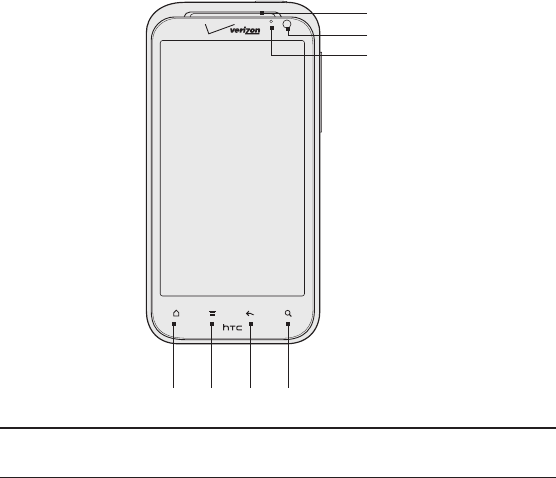
22 Basics
Front panel
32
1
8
7
6
54
1 Earpiece
Listen to a phone call from here.

Basics 23
2 HOME
While on any application or screen, press to return to the Home
screen.
While on the main Home screen, press to show a snapshot of the
extended Home screens.
Press and hold to open the recently-used applications window.
3 MENU
Press to open a list of actions that you can do on the current screen.
4 BACK
Press to go back to the previous screen, or to close a dialog box, options
menu, the Notifications panel, or onscreen keyboard.
5 SEARCH
Press to open Google search.
See “Searching your phone and the Web” in this chapter for more details.
6 Touch screen
7 Front Camera
8 Notification LED
This LED shows a:
Solid green light when the phone is connected to the power adapter
or a computer and the battery is fully charged.
Flashing green light when you have a pending notification.
Solid amber light when the battery is being charged.
Flashing amber light when the battery level reaches very low.
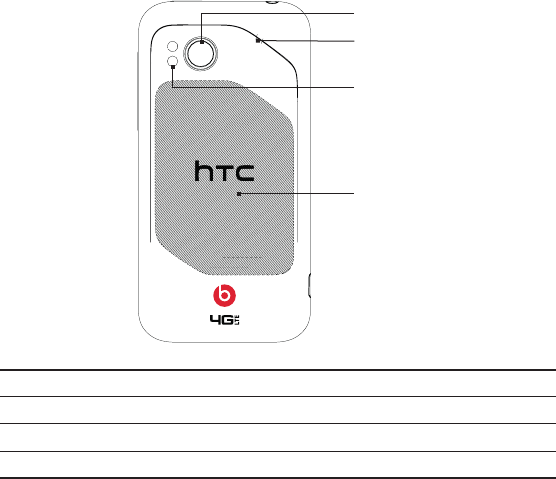
24 Basics
Back panel
9
10
11
12
9 5 megapixel camera
10 Speaker
11 LED flashlight
12 Back cover
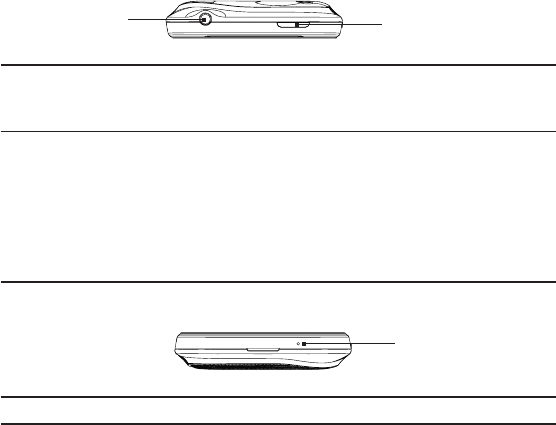
Basics 25
Top panel
13 14
13 3.5mm audio jack
Connect a 3.5mm stereo headset for hands-free conversation or for
listening to music.
14 POWER/LOCK
When the phone is off, press and hold for a few seconds to turn on the
phone.
When the phone is on and the screen is unlocked, press to turn the
phone display off or on.
With the screen unlocked, press and hold to open the phone options
menu that lets you turn off the phone, switch your phone to silent mode,
vibration mode, or airplane mode, and turn on/off the data connection.
Bottom panel
15
15 Microphone
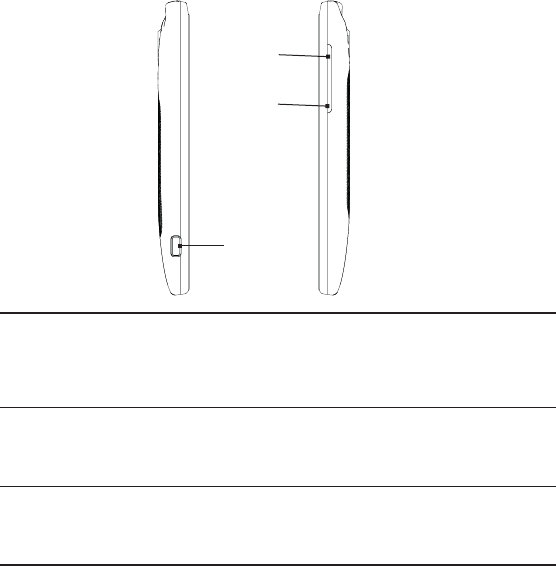
26 Basics
Left and right panels
16
17
18
16 VOLUME UP
While on a call, press to increase earpiece volume.
While not on a call, press to increase the ringer volume.
While watching videos or listening to the FM radio, press to increase
the volume.
17 VOLUME DOWN
While on a call, press to lower the earpiece volume.
While not on a call, press to lower the ringer volume.
While watching videos or listening to the FM radio, press to lower the volume.
18 USB connector
Connect the micro-USB plug of the supplied USB cable to this connector
and then connect the other end to the power adapter to charge the
battery, or to your computer to transfer files.
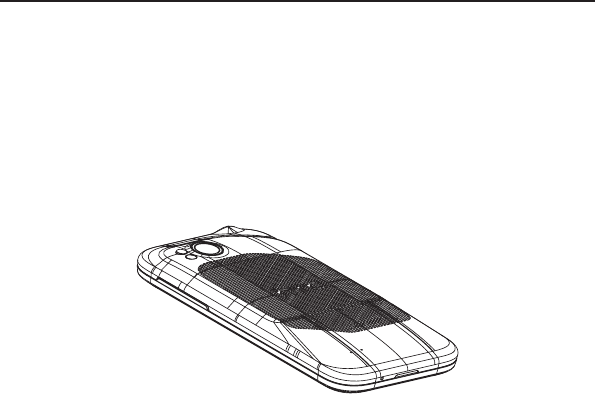
Basics 27
Before turning on your phone
Back cover
Removing the back cover
Remove the back cover to access the battery compartment, storage
card slot and SIM card slot.
Make sure the wireless device is turned off.
Hold the device securely with the front facing down.
With your thumb or finger, lift up the back cover from the notch
at the bottom of the wireless device.
Replacing the back cover
Align and secure the top part of the back cover first.
2. Press the sides and the bottom part of the back cover against
the phone until the back cover clicks into place.
1.
2.
3.
1.
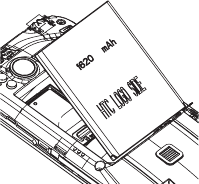
28 Basics
Battery
Your phone uses a rechargeable battery. Please use only original
batteries and accessories that came with your phone or replacements
that we recommend.
How long the battery can last before it needs recharging depends on
how you use your phone. Among these are the phone features and
accessories you use (for example, leaving your Bluetooth connection
always on uses more power). Long phone calls and frequent web
browsing use up much battery. Also, consider your location: poor
signal strength from your mobile network and extreme temperature
make the battery work harder.
Inserting the battery
Align the battery’s exposed copper contacts with the battery
connectors inside the battery compartment.
Insert the contact side of the battery first, and then gently push
the battery into place.
Replace the back cover.
1.
2.
3.
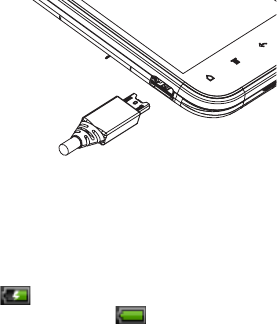
Basics 29
Charging the battery
The battery is partially charged when shipped. Before you turn on
and start using your phone, it is recommended that you charge
the battery. Some batteries perform best after several full charge/
discharge cycles.
Connect one end of the USB cable to the power adapter.
2. Connect the smaller end of the USB cable to the USB connector
on the left side of your wireless device.
3. Plug in the AC charger to a wall socket to start charging the
battery.
As the battery is being charged, the notification LED shows a solid
amber light when the battery is being charged. The light turns to solid
green when the phone is fully charged.
When you charge the battery while the phone is on, the charging
battery icon ( ) displays in the status bar. When the battery is fully
charged, a full battery icon ( ) displays in the status bar.
1.

30 Basics
Use only an approved charging accessory to charge your phone.
Do not remove the battery from the phone while you are charging it
using the AC or car adapter.
As a safety precaution, the battery stops charging when it overheats.
Removing the battery
You’ll need to remove the battery when you want to replace it or when
you need to replace the SIM card.
Remove the back cover. Refer to “Removing the back cover.”
Lift out the battery from the notch near the speaker.
Do not touch or press the speaker when you take out the battery.
1.
2.

Basics 31
Getting started
Once you’ve installed your battery, you can turn on your phone and
start using it.
Turning on your phone
Press and hold the POWER/LOCK button for a few seconds until the
screen turns on.
When you turn on the phone for the first time, you will be prompted
to set up your phone. For more information on how to set up your
phone for the first time, see “Setting up your phone for the first time.”
Turning off your phone
If you do not need to use your phone, you can turn the power off to
save battery life.
If the display is off, briefly press the POWER/LOCK button to POWER/LOCK button to button to
turn the display back on.
Unlock the phone screen. See “Unlocking the screen” in this
chapter for details.
Press and hold the POWER/LOCK button for a few seconds.POWER/LOCK button for a few seconds. button for a few seconds.
When the Phone options menu appears, tap Power off.
Tap OK when asked to turn off the phone.
1.
2.
3.
4.
5.

32 Basics
Setting up your phone for the first time
When you turn on your phone for the first time, your phone displays
tutorials and guides you to set up your email accounts and favorite
social networks such as Facebook®, Flickr®, and Twitter™. You can
follow the onscreen instructions to complete the setup, or skip the
setup and do it at another time.
Choose the phone language you want to use, and then tap Next.
Your phone walks you through a tutorial on how to use the
onscreen keyboard. Follow through the tutorial to learn how
to use the onscreen keyboard. Tap Skip to not go through the
tutorial.
On the Internet connection screen, select how you want to
connect to the Internet, and then tap Next.
If there are Wi-Fi networks in range, you will be asked if you want
to connect to a Wi-Fi network. Tap Next and then tap the wireless
network that you want, or clear the Connect to Wi-Fi network
checkbox, and then tap Next to set up your Wi-Fi connection at a
later time.
Some phone features such as Weather and Footprints require
Google’s location service to automatically determine your current
location. On the Use Google location screen, you can choose
whether to allow Google’s location services to collect information
about your location. Clear or select the checkbox, and then tap
Next.
This service may incur additional data transfer fees from your
provider. You can enable or disable this service later in your
phone’s location settings.
6. On the Set up accounts screen, choose the type of account you
want to set up and follow the onscreen instructions to complete
1.
2.
3.
4.
5.
Basics 33
the setup. Tap Skip to set up accounts at a later time.
To set up your Google Account, tap Google account > Next >
Sign in, enter your Google Account details, and then tap Sign in.
If you want to add a
Microsoft Exchange ActiveSync or a
POP3/IMAP email account, tap these options
to
set them up
on your phone. To learn how to set up these email accounts,
see the Accounts and sync and Email chapters.
After setting up an account, you will be taken back to the Set up
accounts screen so you can set up more accounts. When you are
done setting up your accounts, tap Next.
8. On the Set up social networks screen, choose the type of social
network account that you want to access from your phone.
Follow the onscreen instructions to log in to your social network
account. Tap Skip to set up social network accounts at a later
time. See the Social chapter for more information about social
networks.
When you’re done signing in with your accounts, tap Next to
complete the setup.
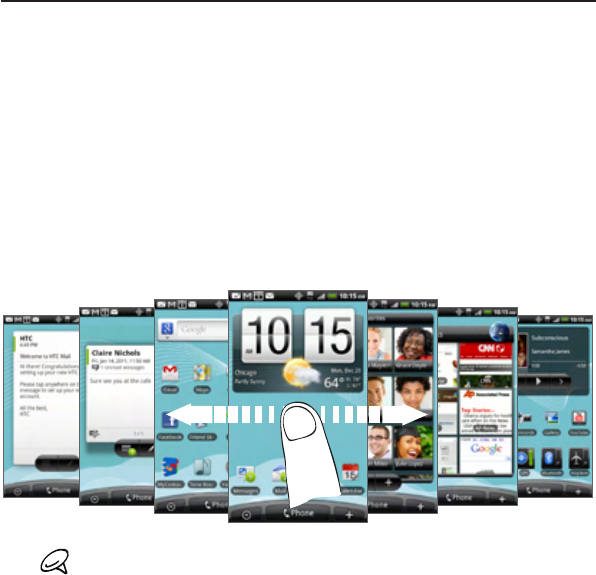
34 Basics
Home screen
The Home screen provides you with a weather clock that shows the
time and weather of your current location. Tap the respective item to
open the associated application.
The Home screen also lets you add the items you want and need
on the Home screen. Add items like application icons, shortcuts,
folders, and widgets to give you instant access to information and
applications. To learn how to personalize your Home screen, see the
Personalizing chapter.
Extended Home screen
The Home screen extends beyond the screen width to provide more
space for adding icons, widgets, and more. There are 6 “additional”
screens apart from the main Home screen.
You cannot add more screens.
Basics 35
Navigating the Home screen
You can go to the extended Home screen by sliding your finger
horizontally across the screen to go to the left or right side of the
Home screen. While on an extended Home screen, press HOME to
return to the main Home screen.
Directly going to a particular screen using Leap view
1. Do any of the following:
While on any Home screen, pinch the screen using two fingers
(for example, thumb and index fingers) to show the Leap view
that shows the screens as thumbnails.
On the main Home screen, you can press HOME to show the
Leap view.
2. Tap the screen you want to open.
Going around the screen with finger gestures
Tap
When you want to type using the onscreen keyboard, select items
onscreen such as application and settings icons, or press onscreen
buttons, simply tap them with your finger.
Press and hold
To open the available options for an item (e.g. contact or link in a web
page), simply press and hold the item.
Swipe or slide
To swipe or slide means to quickly drag your finger vertically or
horizontally across the screen.
36 Basics
Drag
Press and hold your finger with some pressure before you start
to drag. While dragging, do not release your finger until you have
reached the target position.
Flick
Flicking the screen is similar to swiping, except that you need to swipe
your finger in light, quicker strokes. This finger gesture is always in a
vertical direction, such as when flicking the contacts or message list.
Rotate
For most screens, you can automatically change the screen
orientation from portrait to landscape by rotating the phone to the
left. When entering text, you can turn the phone sideways to bring up
a bigger keyboard. Refer to the Settings chapter for more details.
Pinch
For some applications, like Gallery or the web browser, you can “pinch”
the screen using 2 fingers (for example, thumb and index fingers) to
zoom in or zoom out when viewing a picture or a web page.
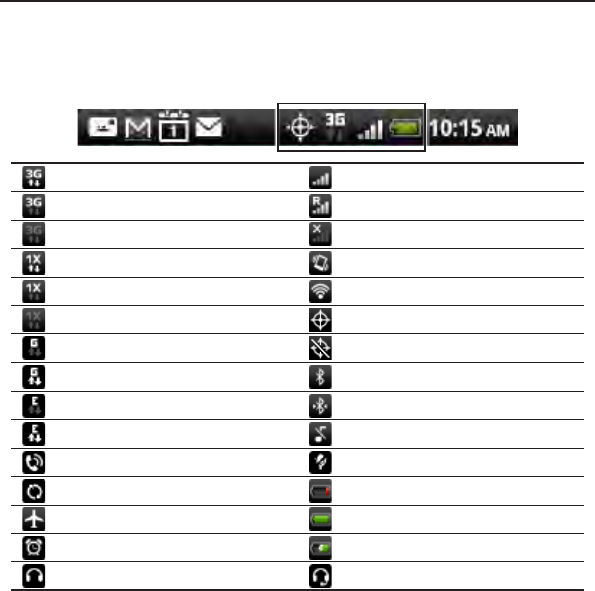
Basics 37
Phone status and notifications
Phone status icons
These are the icons that may appear on the phone status area of the
status bar:
3G data transfer Signal strength
3G connected Roaming
3G in idle mode No signal
1xRTT data transfer Vibrate mode
1xRTT connected Connected to a Wi-Fi network
1xRTT in idle mode Location setting on
GPRS connected Location setting off
GPRS in use Bluetooth is on
EDGE connected Connected to a Bluetooth device
EDGE in use Phone speaker is mute
Speakerphone on Phone microphone is mute
Data synchronizing Battery is very low (10% remaining)
Airplane mode Battery is full
Alarm is set Battery is charging
Wired headset connected Wired microphone headset connected
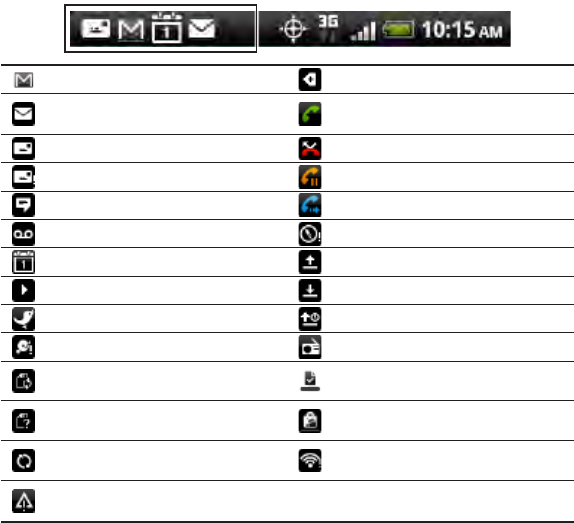
38 Basics
Notification icons
These are the icons that may appear on the notifications area of the
status bar:
New Gmail message More (not displayed) notifications
New Microsoft Exchange
ActiveSync or POP3/IMAP email Call in progress
New SMS/MMS Missed call
Problem with SMS/MMS delivery Call on hold
New Google Talk instant message Call forwarding on
New voicemail Compass needs orientation
Upcoming event Uploading data (animated)
Song is playing Downloading data (animated)
New tweet Waiting to upload
Storage card is low on free space FM Radio is on
Storage card is safe to remove or
storage card is being prepared
Downloaded Android Market
application installed successfully
No storage card installed on the
phone
Update available for an application
downloaded from Android Market
Data synchronizing or connected
to HTC Sync
Wi-Fi is on and wireless networks
are available
General notification (for example, the phone is connected to the computer
via the USB cable.)
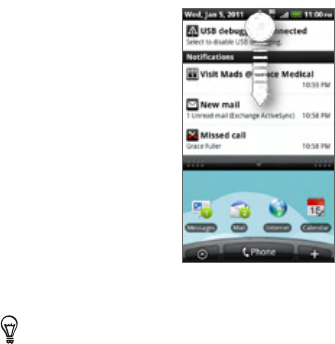
Basics 39
Checking notifications
Notification icons on the status bar tell you of new messages,
calendar events, alarms set and ongoing or missed calls. You can
open the Notifications panel to open the message, reminder, or event
notification and see the mobile operator name.
Opening the Notifications panel
When a new notification icon displays in the status bar, press and
hold the status bar, then slide your finger downward to open the
Notifications panel.
If you have several notifications, you can scroll down the screen to
view more notifications.
You can also open the Notifications panel on the Home screen by
pressing MENU and then tapping Notifications.
Closing the Notifications panel
Do one of the following:

40 Basics
Press and hold the bottom bar of the Notifications panel, then
slide your finger up the screen.
Press BACK.
Adjusting the volume
Adjusting the ringer volume changes the volume level of the phone
ringtone, whereas adjusting the media volume changes the volume
level of sound notifications, music or video playback. The ringer
volume and media volume can be separately adjusted.
Adjusting the ringer volume
Press the VOLUME UP or VOLUME DOWN buttons on the left
panel of the phone to adjust the ringer volume to your desired
level. The Ringer volume window appears on the screen to
display the volume levels.
While in the lowest ringer volume level (Silent mode), press
VOLUME DOWN once to set your phone to Vibrate mode. The
phone vibrates and the vibrate mode icon ( ) appears on the
status bar.
While in Vibrate mode, press VOLUME UP once to switch to silent
mode. The speaker mute icon ( ) displays on the status bar.
To quickly switch your phone to silent mode or vibration mode,
press and hold the POWER/LOCK button, and then tap Silent
mode or Vibration mode on the options menu.
Adjusting the media volume
When playing music or watching video, press the VOLUME UP or
VOLUME DOWN buttons on the left panel of the phone to adjust the
1.
2.
3.

Basics 41
media volume. The Media volume window appears on the screen to
display the volume level.
You can also adjust the media volume on the Settings screen.
From the Home screen, press MENU, and then tap Settings >
Sound > Volume.
When the Volume window appears, drag the Media slider to the
left to lower the volume or to the right to increase the volume.
Tap OK to close the window.
Sleep mode
Sleep mode suspends your phone to a low power state while the
display is off in order to save battery power. You will still be able to
receive messages and calls while the phone is in Sleep mode.
For information on how to adjust the time before the screen turns off, see
“Adjusting the time before the screen turns off” in the Settings chapter.
Switching to Sleep mode
Briefly press the POWER/LOCK button to turn off the display
temporarily and switch your phone to Sleep mode. Your phone also
automatically goes into Sleep mode when left idle after a period of
time. Switching to Sleep mode also prevents accidental button or
touch screen presses when the phone is in your bag or pocket.
Waking up from Sleep mode
Your phone wakes up automatically when you have an incoming call.
To wake up your phone manually, press the POWER/LOCK button.
You will then see that the phone has locked the screen. To find out
how to unlock the screen, see “Unlocking the screen.”
Unlocking the screen
1.
2.
3.
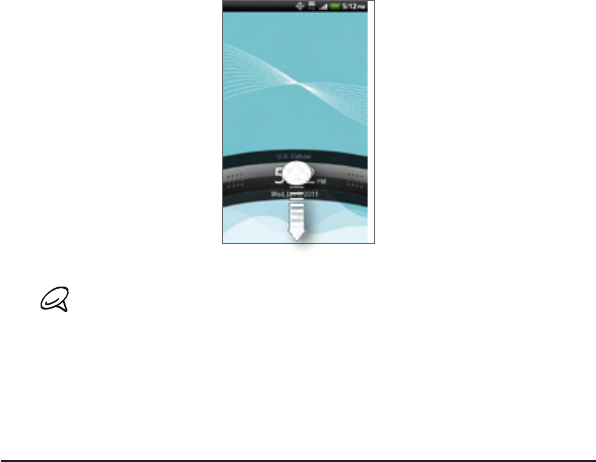
42 Basics
Press the bar on the lock screen and then slide your finger down to
unlock the screen or to answer an incoming call.
If you have set up a screen unlock pattern, pin, or password, you
will be asked to draw the pattern on the screen or enter the PIN
or password before it unlocks. For more information on how to
create and enable the screen unlock pattern, PIN, or password, see
“Protecting your phone with a screen lock” in the Security chapter.
Connecting your phone to a computer
Whenever you connect your phone to a computer using the USB
cable, the Connect to PC dialog box displays and prompts you to
choose the type of USB connection. Select one of the following
choices, and then tap Done:
Basics 43
Charge only
Select this mode if you only want to charge the phone’s battery using
your computer.
HTC Sync
When selected, the phone automatically uses HTC Sync when
connected to your computer and lets you synchronize Outlook and
Windows Address Book (Outlook Express), contacts and calendar
events between your computer and your phone. For more information,
see “Using HTC Sync” in the Accounts and sync chapter.
Disk drive
This mode is available only when you have installed a microSD card on
your phone. Select this mode when you want to use your storage card
as a USB thumb drive, and copy files between your phone’s storage
card and your computer.
When Disk Drive mode is enabled while your phone is connected to
the computer, you will not be able to run applications that use the
storage card, such as Music or Gallery. For more information, see
“Copying files to and from the storage card” in this chapter.

44 Basics
USB tethering
When you do not have Internet connection on your computer, you
can select this mode to share your phone’s mobile data connection
with your computer. For more information, see “Using Your Phone as a
Modem” in the Internet chapter.
If you do not want to show the Connect to PC dialog box everytime
you connect the phone to the computer, select the Don’t ask
me again checkbox in the Connect to PC dialog box. The default
connection type will be used when you connect the phone to the
computer.
To check or change the default connection type and to show or hide
the Connect to PC dialog box, press HOME > MENU, and then tap
Settings > Connect to PC.

Basics 45
Copying files to and from the storage card
Connect the phone to your computer using the supplied USB
cable.
When the Connect to PC dialog box appears, tap Disk drive, and
then tap Done.
On your computer, the connected phone is recognized as a
removable disk. Navigate to this removable disk and open it.
Do one of the following:
Copy the files from the computer to the phone’s storage
card’s root folder.
Copy the files from the phone’s storage card to a folder in
your computer or computer desktop.
5. After copying the files, unmount the removable disk (that is, the
connected phone) as required by your computer’s operating
system to safely remove your phone.
6. Do one of the following:
Disconnect the phone from the computer.
If you want to keep the phone connected to the computer but
want the phone to be able to access the storage card, open
the Notifications panel, tap Disk drive, select an option except
Disk drive, and then tap Done. See “Opening the Notifications
panel” in this chapter to learn how to open the Notifications
panel.
1.
2.
3.
4.
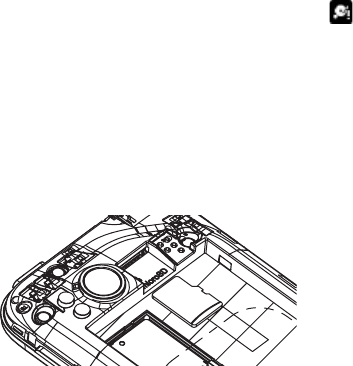
46 Basics
Replacing the storage card
When the storage card is almost full, you’ll see this icon in the
status bar. You can replace the storage card with a new one.
Remove the back cover. See “Removing the back cover.”
Remove the battery. See “Removing the battery.”
Locate the storage card slot lock and then push it down with
your thumb.
Use another finger to slide the storage card out of the slot.
Insert the new microSD card into the slot with its gold contacts
facing down and push it until it is in place.
Removing the storage card while the phone is on
When you need to remove the storage card while the phone is on,
unmount the storage card first to prevent corrupting or damaging the
files in the storage card.
From the Home screen, press MENU, and then tap Settings.
Scroll down the screen, and then tap SD & phone storage.
Tap Unmount SD card.
Remove the storage card by following the instructions in
“Replacing the storage card.”
1.
2.
3.
4.
5.
1.
2.
3.
4.

Basics 47
Searching your phone and the Web
You can search for information on your phone and on the Web. Some
applications, such as People or Mail, have their own search box, which
you can use to search within those applications (the application’s icon
is at the left of the search box.)
From the Home screen, press SEARCH.
If this is the first time that you’re doing a search, Google will ask
whether you’ll turn on your personalized search history and use
its location service. Tap the desired option.
Enter the search item in the search box. As you type, matching
items on your phone and suggestions from the web appears
below the search box.
Tap an item to open it in the appropriate application.
1.
2.
3.
4.

Personalizing
Making your phone truly yours
Make your phone look and sound just the way you want it. Personalize
your phone with a different wallpaper, ringtone, and notification sound
for events such as incoming text, email, calendar reminders, and more.
Your phone’s Home screen is highly customizable and extends beyond
the screen width, giving you plenty of space to add the information
that matters most in your daily life and phone features that make
communication quicker and easier. You have up to seven screens that
extend to the left and right sides of your display as your Home screen,
on which you can add elements such as widgets, program icons,
shortcuts to information, and more.
To find out how to set notification sounds for events, see “Changing
sound settings”.
Changing the ringtone
Choose from the available selections of ringtones on your phone.
From the Home screen, press MENU and then tap Settings.
Tap Personalize > Default ringtone. The Phone ringtone selection
menu then opens.
Scroll through the available ringtones and tap the ringtone you
want to use. The ringtone briefly plays when selected.
Tap OK.
1.
2.
3.
4.

50 Personalizing
You can also download or copy ringtones or songs to your phone’s
storage card. To find out how you can copy files to your storage card,
see “Copying files to and from the storage card“.
Ringtones or songs downloaded or copied to your storage card are
not automatically added to the ringtone selection menu. You need
to go to the Music application and set a ringtone or song in your
storage card as your ringtone. To find out how to set a ringtone using
the Music application, see “Setting a song as ringtone” in the Music
chapter.
Personalizing your phone with scenes
Your phone becomes multiple phones in one when you use scenes.
Scenes are personalized Home screen layouts that you can quickly
apply to your phone. By switching between scenes, you instantly turn
your phone into your perfect weekend phone, travel phone, work
phone, or pure play phone.
Using a preset scene
Your phone features preset scenes, each preconfigured with a
different collection of widgets that reflect different moments in your
life. You can choose a scene that is suitable for work, play, travel, or
your social life.
From the Home screen, press MENU and then tap Scenes.
In the Choose a scene menu, select a preset scene and then tap
Done.
1.
2.
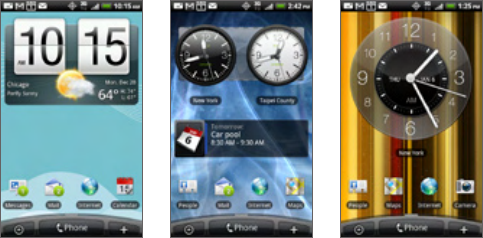
Personalizing 51
U.S. Cellular (default) Work Play
Customizing and saving a scene
After selecting a preset scene, you can add widgets and other
elements, arrange the layout, change the wallpaper, and save the
whole Home screen as your personalized scene.
From the Home screen, press MENU and then tap Scenes.
In the Choose a scene menu, select a preset scene that already
has some widgets, or select Clean Slate if you want to design
your own Home screen.
Add widgets and other elements that you want.
Arrange the layout of your Home screen according to your
preference.
Change the Home screen wallpaper. You can also change the
lock screen wallpaper.
When you are done designing your Home screen, press
HOME > MENU and then tap Scenes again.
1.
2.
3.
4.
5.
6.

52 Personalizing
Under My scenes, make sure the Current (unsaved) option is
selected and then tap Save.
Enter a new scene name for your Home screen and then tap
Done. Or, if you already created a scene, enter the same scene
name, tap Done and then tap Replace.
Renaming or deleting a scene
You can rename or delete a personalized scene that you created.
Preset scenes cannot be renamed or deleted.
From the Home screen, press MENU and then tap Settings >
Personalize > Scenes.
Under My scenes, press and hold a scene and choose whether to
rename or delete it.
Changing your wallpaper
Personalizing your Home screen wallpaper with your favorite photo is
a quick and easy way to change the feel of your phone and give it a
fresh look. Browse the collection of wallpapers included in your phone
or choose from photos that you have taken with the camera. You can
also change your Home screen to use an animated wallpaper.
The wallpaper that you choose for the Home screen will also be used
as the lock screen wallpaper.
From the Home screen, press MENU and then tap Wallpaper.
Do one of the following:
Tap Live wallpapers to choose from preset animated
wallpapers.
Tap HTC wallpapers to select from preset wallpapers.
7.
8.
1.
2.
1.
2.

Personalizing 53
Tap Gallery to select a photo that you have taken using the
camera or copied to your storage card. Crop the photo and
then tap Save.
After changing the wallpaper, remember to save it to the scene
that you created or save it as a new scene. To find out how to
save a scene, see “Customizing and saving a scene”.
Personalizing your Home screen with widgets
Widgets put at-a-glance important information and media content
up front on your Home screen. Some widgets are already added to
your Home screen for your convenience. You can add more from the
available selections of widgets, or download more widgets.
Adding a widget to your Home screen
A wide selection of widgets is available for you to choose from, such
as Calendar, Music, Photo Album, Friend Stream, Twitter, and more.
On the Home screen, go to the part where there’s space to add a
new widget. To find out how, see “Navigating the Home screen”
in the Basics chapter.
Tap or press and hold on the Home screen to open the Add
to Home options menu.
Tap Widget and then select a widget that you want.
Most HTC widgets are available in a variety of designs and sizes
to suit your needs. Tap the right or left arrow button at the
bottom of the screen to view the different styles, and then tap
Select to choose one.
3.
1.
2.
3.
4.
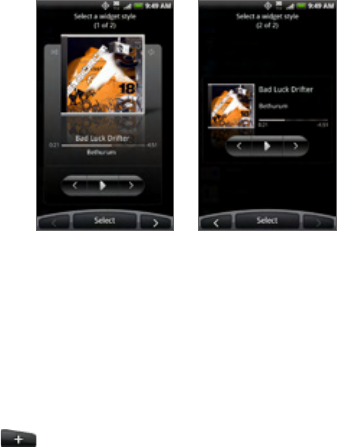
54 Personalizing
You can also add widgets that allow you to quickly switch on or
off certain settings of your phone, such as Wi-Fi, Mobile Network,
Bluetooth, and more. Scroll down the widgets list, tap Settings, and
then tap the widget that you want.
Downloading HTC widgets
A selection of fun and useful HTC widgets are also available for download.
On the Home screen, go to the part where there’s space to add a
new widget. To find out how, see “Navigating the Home screen”
in the Basics chapter.
Tap or press and hold on the Home screen to open the Add
to Home options menu.
Tap Widget and then tap Get more HTC widgets.
Tap to select a widget.
Tap Details to see a short description about the widget. After
reading, press BACK.
When you’re ready to download and add the widget to your
Home screen, tap Download.
1.
2.
3.
4.
5.
6.

Personalizing 55
Adding application icons and other shortcuts on
your Home screen
Place application icons on your Home screen to open applications
quicker. You can also add shortcuts to settings and specific
information such as a bookmarked webpage, someone’s phone
number, a music playlist, route directions, and many other items, to
your Home screen.
The shortcuts available depend on the applications that are installed
on your phone.
On the Home screen, go to the part where there’s space to add a
new widget. To find out how, see “Navigating the Home screen”
in the Basics chapter.
Tap or press and hold on the Home screen to open the Add
to Home options menu.
Do one of the following:
To add an application icon, tap App and then select an
application.
To add a shortcut to a setting or information, tap Shortcut and
then select the type of information or setting.
To add an application icon on the Home screen, you can also press
HOME, tap , and then press and hold an application icon. Without
lifting your finger, drag the icon to an empty area on the Home
screen, and then release it.
1.
2.
3.
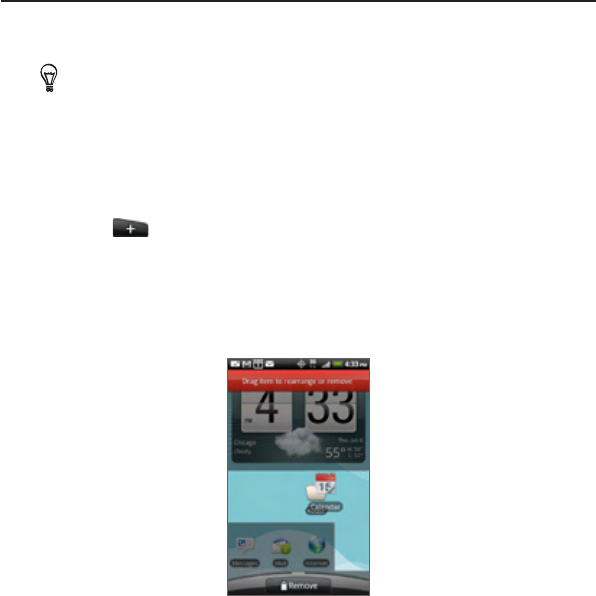
56 Personalizing
Adding folders on your Home screen
Use folders to group related applications and other shortcuts to keep
your Home screen tidy and organized.
You can also add information folders that show up-to-date
information such as Bluetooth received files, your Facebook
phonebook, and more.
Creating a new folder and adding items to it
On the Home screen, go to the part where there’s space to add a
new widget. To find out how, see “Navigating the Home screen”
in the Basics chapter.
Tap or press and hold on the Home screen to open the Add
to Home options menu.
Tap Folder and then tap New Folder.
Press and hold an application icon or a shortcut that you want to
move to the folder. The phone then vibrates. Don’t lift your finger.
Drag the application icon or shortcut and drop it on top of the folder.
1.
2.
3.
4.
5.

Personalizing 57
Simply tap the folder to open it so you can access the applications
and shortcuts inside the folder.
Renaming a folder
Tap the folder to open it.
Press and hold the folder window’s title bar.
Enter a new folder name and then tap OK.
Rearranging or removing widgets and icons on
your Home screen
Rearrange the widgets and icons on your Home screen to give room
for adding more items to the Home screen. You can also remove
widgets and icons that you don’t frequently use.
Moving a widget or icon
Press and hold the widget or icon you want to move.
The phone vibrates and you’ll see a green box around the widget
or icon. Don’t release your finger.
Drag the widget or icon to a new location on the screen.
Pause at the left or right edge of the screen to drag the widget
or icon onto another Home screen panel.
When the widget or icon is where you want it, release your finger.
If you’ve released your finger but a message shows that there’s
no space to place the widget or icon, drag it right or left again to
another Home screen panel.
1.
2.
3.
1.
2.
3.
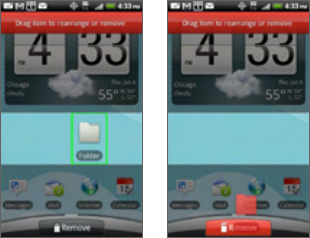
58 Personalizing
Removing a widget or icon
Press and hold the widget or icon you want to remove.
The phone vibrates and you’ll see a green box around the widget
or icon. Don’t release your finger.
Drag the widget or icon to the Phone button. The Phone button
then changes into the Remove button and turns red.
When the widget or icon also turns red, release your finger.
1.
2.
3.
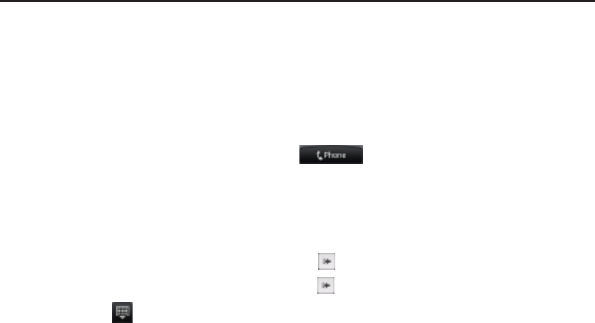
Phone calls
Making calls
There are several convenient methods to make a call from your phone.
Calling somebody using your phone
You can either dial a number directly, or you can use the Smart Dial
(see “Smart Dial”) feature to search and call a contact in your contacts
lit or a number from call history.
From the Home screen, tap .
Begin entering the first few digits or characters by tapping the
keys on the phone keypad. As you enter digits or letters, the
panel displays numbers and names that match the keys you
tapped.
If you enter a wrong digit, tap to erase that digit. To erase the
entire number, press and hold .
Tap to close the phone keypad and to see if there are more
matching numbers or contacts. To browse through the filtered
list, flick through the list or slide your finger up or down the list
slowly.
To place a call, do one of the following:
If there are no matching contacts in the list, after entering the
number, tap Call.
Tap the phone number or contact from the list.
1.
2.
3.
4.

60 Phone calls
To call a different phone number associated with the contact,
tap at the right side of the contact name. On the contact
details screen, tap the number you want to call.
Making international calls
Your phone lets you make calls from the U.S. to any phone on the
globe. See “Global Phone” in this chapter for more information.
From the Home screen, tap .
Press and hold “0” on the phone keypad until the plus sign (+)
appears.
Enter the full phone number you want to dial. The full phone
number includes the country code, area code (without the
leading zero, if any), and phone number.
Tap Call.
Smart Dial
The phone dialer’s Smart Dial feature makes it quick and easy for you
to place a call. Simply enter the phone number or first few letters of
the person you want to call. Smart Dial automatically searches and
filters your contacts list stored on your phone, and the phone numbers
from the call history.
Calling a speed dial number
From the Home screen, tap .
On the phone keypad, press and hold the number that is
associated with the contact you want to call.
The number 1 on the phone keypad is generally reserved for
your voicemail. Press and hold this button to call voicemail and
retrieve your voicemail messages.
1.
2.
3.
4.
1.
2.
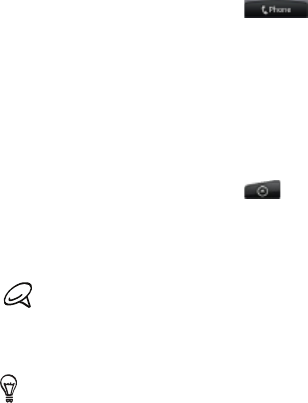
Phone calls 61
Adding a contact to speed dial
From the Home screen, tap .
Press MENU, and then tap Speed dial > Add new.
Enter the name of the contact you want to add. When the name
comes up in the list, tap the name.
On the Speed dial screen, select the phone number of the
contact to use, and the phone keypad assignment. Tap Save.
Calling using Voice Dialer
From the Home screen, tap > Voice Dialer.
When the Voice Dialer message box appears and you see
“Listening” on the screen, say “Call [name of person]” in a clear
voice into the phone.
The person you want to call should be in your People list.
A confirmation message will pop up asking if the person to call is
correct. Tap OK if the person is correct or tap Cancel to try again.
If the contact has more than one number, or if the Voice Dialer does
not detect your voice accurately, the confirmation message displays
a list of the contact’s phone numbers or suggested results.
You can also use voice Dialer to open programs.
Calling a phone number in a text message
From the Home screen, tap Messages, and then tap the message
with the phone number.
In the message thread, tap the message with the phone number.
On the Select link screen, tap the number you want to call.
1.
2.
3.
4.
1.
2.
3.
1.
2.
3.

62 Phone calls
Edit the phone number if needed, and then tap Call.
To call the message sender, in the All messages list, press and hold
the message, and then tap Call on the options menu.
For more information about text messages, see the Messages chapter.
Calling a phone number in an email
From the Home screen, tap Mail.
Open the email account where the email with the number is
located.
In the email account’s inbox, tap the email to open it.
In the email body, tap the phone number. The phone dialer screen
opens with the phone number already entered.
The phone will recognize a number as a phone number if the number
has a minimum of 5 digits and have at least one of the following:
Numbers preceded by a “+” in front. For example, +1-987-654-
321 or +1987654321.
Numbers enclosed in parenthesis in front. For example,
(02)987654321 or (02)987-654-321.
Numbers separated by dashes. For example, (02)-987-654-321
or 0987-654-321.
Tap Call.
For more information about email, see the Email chapter.
Making an emergency call
On the phone dialer screen, dial the international emergency number
for your locale (for example, 911), and then tap Call.
4.
1.
2.
3.
4.
5.
Phone calls 63
Using Assisted Dialing
Assisted Dialing allows you to easily dial international calls while
roaming in another country.
Setting up assisted dialing
From the Home screen, press MENU then tap Settings > Call >
Assisted Dialing.
Select the Enable Assisted Dialing check box.
Tap Reference Country, and then select the country that you
want to call.
Check the dialing preferences, such as the IDD/NDD Prefix and
Area/City Code, and then do any of the following:
If the dialing preferences are correct, tap Done.
If you want to edit the dialing preferences, press MENU and
then tap Edit. Change the dialing preferences, and then tap
Save.
The next time you dial a phone number, the IDD/NDD prefix and area/
city code is automatically added before the number.
Setting a default reference country
If you always call a particular country when you’re abroad, you can set
it as the default reference country.
From the Home screen, press MENU then tap Settings > Call >
Assisted Dialing.
Select the Enable Assisted Dialing check box.
Tap Reference Country, and then select the country that you
want to set as default.
Press MENU and then tap Set Default.
1.
2.
3.
4.
1.
2.
3.
4.
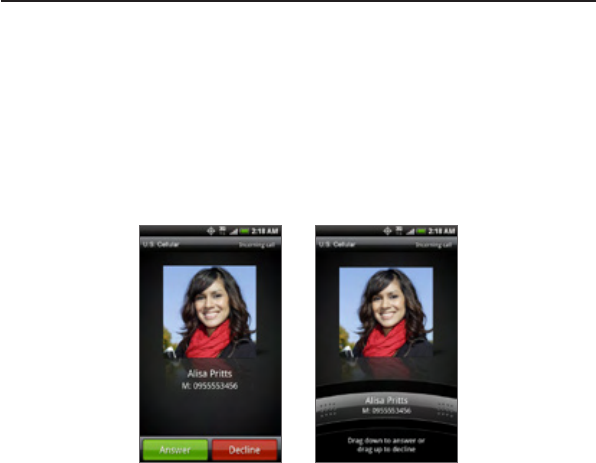
64 Phone calls
Receiving calls
When you receive a phone call from a contact, the Incoming call
screen appears and displays the caller ID icon, name, and phone
number of the calling party. When you receive a phone call from
someone who is not stored in People, only the default caller ID icon
and phone number appear on the Incoming call screen.
Answering an incoming call
If the display is on, tap Answer.
If the display is off, the display will turn on showing the Lock
screen. Drag the bar down to answer the call.
Muting the ringing sound without rejecting the call
Do one of the following:
Press the VOLUME DOWN button.
Place the phone face down on a leveled surface.

Phone calls 65
If the phone is already facing down, the phone will still ring when
there are subsequent incoming calls.
Using the Quiet ring on pick up feature
Your phone is set to automatically scale down the ring volume when
you pick it up to answer calls. To check if this feature is enabled, or to
disable it:
From the Home screen, press MENU then tap
Settings > Sound.
Scroll down the screen, and then select or clear the Quiet ring on
pickup check box.
Press BACK.
Rejecting an incoming call
Do any of the following:
If the display is on, tap Decline.
If the display is off, the display will turn on showing the Lock
screen. Drag the bar up.
If the display is off, the display will turn on showing the Lock
screen. Press MENU, and then tap Decline.
The call is rejected and is sent to your voicemail.
Rejecting a call and sending a text message
You can automatically send a default text message to the caller and
reject the incoming call.
To reject and send a message when you receive an incoming call,
press MENU, and then tap Send message.
1.
2.
3.
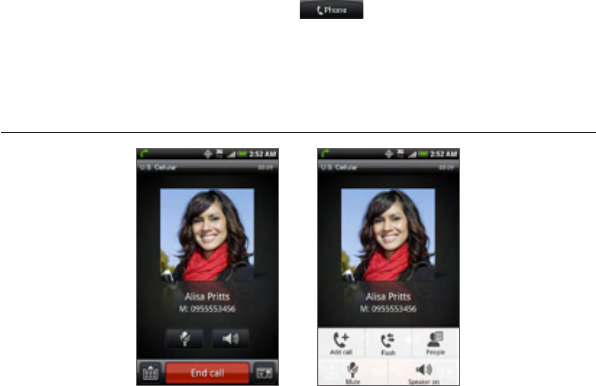
66 Phone calls
Editing the default message
You can change the message that is sent out.
From the Home screen, tap .
Press MENU, and then tap Settings > Edit default message.
Enter the new message, and then tap OK.
Using in-call options
When a call is in progress, use the buttons onscreen to mute or
unmute the microphone or to turn the speakerphone on or off. You
can also press MENU to open the call options to let you add a call,
place the call on hold, mute the microphone, and more.
1.
2.
3.
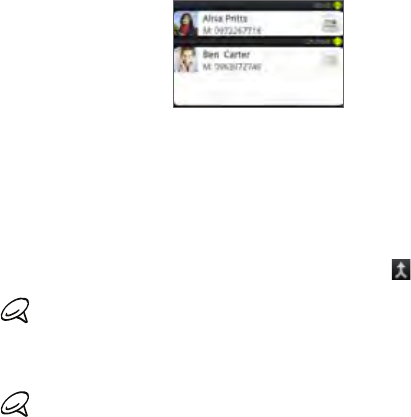
Phone calls 67
Handling multiple calls
Your phone notifies you when you have another incoming call, and
gives you the option of rejecting or accepting the call. If you are
already on a call and accept the new call, you can choose to switch
between the two callers.
When you receive another call, tap Answer to accept the second
call, and to put the first call on hold.
To switch between callers, tap the person you want to talk to on
the screen, or press MENU, and then tap Flash.
To end the current call and return to the other call, tap End call.
Setting up a three-way conference call
1. Make a call to the first participant.
2. When connected, press MENU, tap Add call, dial the number of
the second participant, and then tap Call. The first participant is
put on hold when you dial another participant.
3. When connected to another participant, tap (merge).
The conference call is put on hold when you call another contact.
When you are connected to the other contact, you can talk to that
party in private.
4. When finished, tap End call.
Not all mobile networks support conference calling. Contact U.S.
Cellular for details.
1.
2.
3.
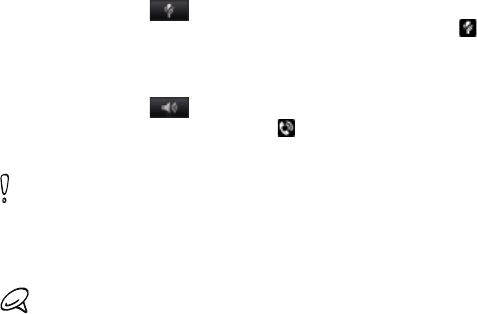
68 Phone calls
Muting the microphone during a call
On the screen, tap to toggle between turning the microphone on
or off. When the microphone is turned off, the Mute icon ( ) appears
in the status bar.
Turning the speakerphone on or off during a call
On the screen, tap to toggle between turning the speakerphone
on or off. The Speakerphone icon ( ) appears in the status bar when
the speakerphone is on.
To avoid damage to your hearing, do not hold your phone against
your ear when the speakerphone is turned on.
Ending a call
On the screen, tap End call.
If the phone display is off, press POWER/LOCK to turn on the screen
so you can tap End call.
If the phone number of the person who called is not in your contacts
list, you can choose to save the number to your contacts list after you
hang up.
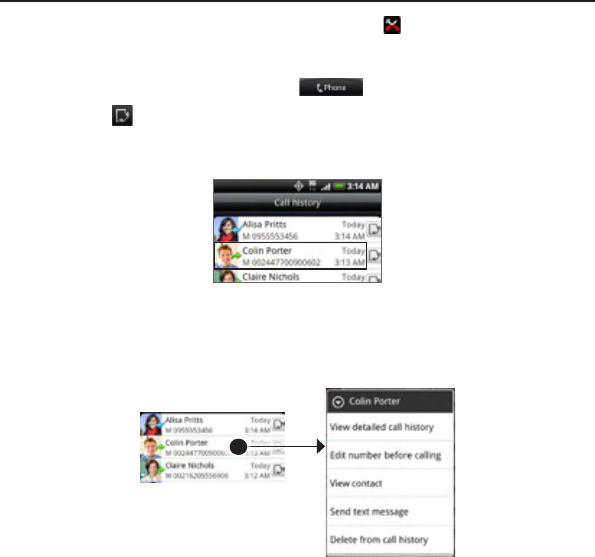
Phone calls 69
Using call history
When you miss a call, the missed call icon ( ) appears in the title
bar. Use the Call history tab in the People application to check who
the caller was or view all your dialed numbers and received calls.
From the Home screen, tap .
Tap at the bottom-right corner of the screen.
Do one of the following:
Tap the name or number in the list to call.
Press and hold a name or number in the list to display the
options menu where you can select to view the contact
information (if the number is stored in your contacts list), edit
the number before you redial, send a text message, or delete
from call history.
1.
2.
3.
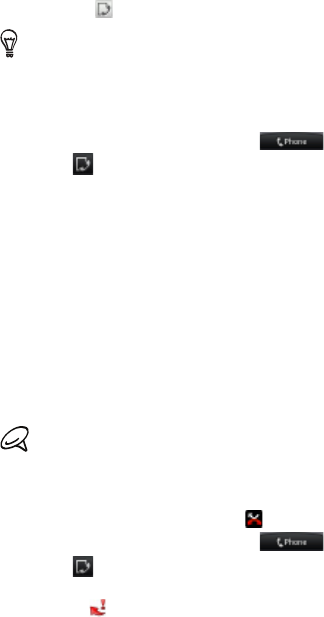
70 Phone calls
Tap to show the call history for that particular contact.
You can also access call history from the People application. See the
People chapter for more information.
Adding a new phone number to your contacts from call
history
From the Home screen, tap .
Tap at the bottom-right corner of the screen.
Press and hold the received call or number that is not in your
contacts list that you want to save to your contacts list, and then
tap Save to People.
In the Create contact under account options menu, choose which
account you’d like to save your contact (for example, Google).
In the blank contact record that appears, enter the contact name
and other information. The phone number is automatically added
to the Mobile field in the Phone section.
To store it as another type of number, for example a home
number, tap the Mobile button.
Scroll down the screen and tap Save.
To learn how to add new contacts or edit the contact information, see
the People chapter.
Checking a missed call
You will see the missed call icon in the status bar when you miss a call.
From the Home screen, tap .
Tap at the bottom-right corner of the screen.
In the call history list, missed calls are indicated by the missed call
icon ( ).
1.
2.
3.
4.
5.
6.
1.
2.
3.
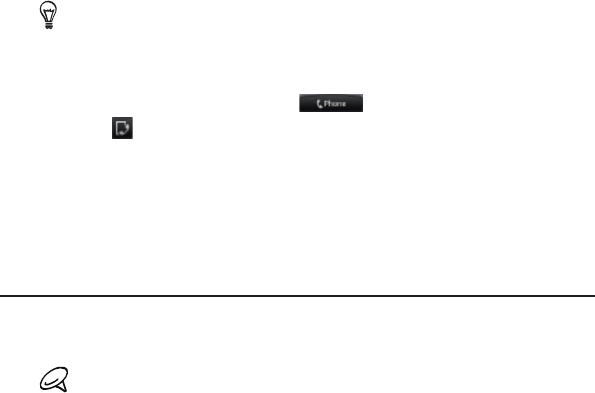
Phone calls 71
You can also press and hold the status bar, and then slide your finger
downward on the screen to open the Notifications panel. The missed
call number or contact name is displayed.
Clearing the call history list
From the Home screen, tap .
Tap at the bottom-right corner of the screen.
Do one of the following:
To remove one name or number from the list, press and hold
the name or number, and then tap Delete from call history.
To clear the entire list, press MENU, and then tap Delete all.
Global Phone
When you’re travelling abroad, you can use a SIM card to let your
phone access a mobile network in the country you’re in.
SIM cards must be purchased from a carrier in the country you wish
to use the phone and are not sold or supported by U.S. Cellular.
Inserting a SIM card
Your wireless phone is set to CDMA mode by default. If you install a
SIM card, the phone automatically switches to Global mode, which
enables you to use your phone globally on GSM networks while
outside of the United States.
Remove the back cover and remove the battery.
See the Basics chapter for more information.
Remove the SIM card from its packaging.
1.
2.
3.
1.
2.
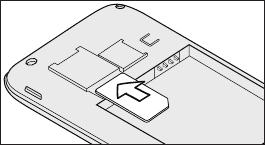
72 Phone calls
Hold the SIM card so that the metal contacts on the SIM card
face down and the cutoff corner of the SIM card points toward
the bottom-left corner of your phone.
4. Slide the SIM card into the SIM card holder until it stops.
5. Insert the battery so that the metal contacts on the battery align
with the metal contacts on your phone. See the Basics chapter
for more information.
6. Replace the back cover. See the Basics chapter for more
information.
Calling from outside of the U.S.
You can use your phone to call outside the U.S. by using a SIM card in
another country. This means that you can stay connected even when
you are in a country that has GSM coverage.
Changing the network your phone connects to
Your phone is set to Global mode and automatically searches for
the appropriate network in your location (CDMA or GSM) and then
connects to it.
3.

Phone calls 73
When roaming in countries outside of North America where both
CDMA and GSM networks are present, you can make your phone to
connect to a CDMA or a GSM network only.
From the Home screen, press MENU and then tap Settings.
Tap Wireless & networks > Mobile networks > Preferred network,
and then select CDMA Mode or GSM / UMTS Mode.
Call services
Your phone can directly link to the mobile phone network, and enable
you to access and change the settings of various phone services for
your phone. Call services may include call forwarding, call waiting,
voicemail, and more. Contact U.S. Cellular to find out about the
availability of call services for your phone.
To open call services, press HOME > MENU, and then tap
Settings > Call.
Voicemail service
Shows the current voicemail service being used.
Voicemail settings
Specify the voicemail number.
Clear voicemail notification
If you have a notification of a new voicemail, you can clear the
notification with this option.
Auto Retry
When enabled, the phone automatically redials a number when the
attempted call fails.
1.
2.

74 Phone calls
Hearing aids
Turn on the Hearing Aid Compliance feature that reduces interference
to hearing aids.
Preferred Network
Let’s you select the type of network your phone connects to so you
can place phone calls and have data connection.
GSM call settings
If you’re using the phone outside of the United States in a GSM
coverage area, you can set the following options:
TTY mode Allow the use of a TTY (teletypewriter) device for
users who are visually or hearing impaired.
Caller ID Enable or disable Caller ID.
Call waiting Enable or disable Call waiting.
Cell broadcast Enable or disable receipt of cell broadcast messages
from your service provider.
Cell broadcast
settings
Configure channels and language for cell broadcast
messages.
CDMA call settings
If you’re using the phone within the United States, or outside of the
United States in a CDMA coverage area, you can set the following
options:
TTY mode Allow the use of a TTY (teletypewriter) device for
users who are visually or hearing impaired.
NBPCD Set the calling parameters for the current country,
such as country code and IDD prefix.
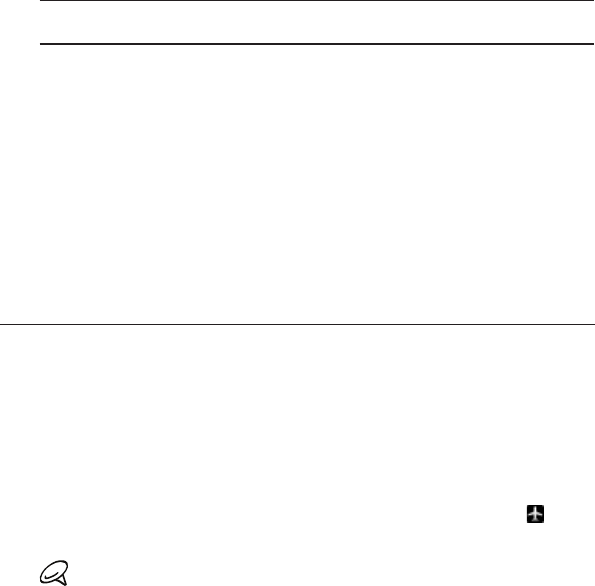
Phone calls 75
Voice Privacy Encrypts outgoing voice calls and uses secure
channels when available.
Assisted Dialing
Assisted Dialing allows you to easily dial international calls while
roaming in another country. See “Using Assisted Dialing” in this
chapter for details.
Phone settings
Edit the call reject message, choose whether to open the message
editor when you reject a call with a message, and choose whether to
allow automatic saving of an unknown contact number when a call
with that number ends.
Turning Airplane mode on or off
In many countries, you are required by law to turn off the phone while
on board an aircraft. A way to turn off the phone function is to switch
your phone to Airplane mode. When you enable Airplane mode,
all wireless radios on your phone are turned off, including the call
function, data services, Bluetooth, and Wi-Fi.
From the Home screen, press MENU then tap Settings >
Wireless & networks.
Select or clear the Airplane mode check box to enable or disable
Airplane mode. When enabled, the Airplane mode icon ( ) is
displayed in the status bar.
When you disable Airplane mode, the call function is turned back on
and the previous state of Bluetooth and Wi-Fi is restored.
1.
2.

People
About People
In People, you can easily manage your communications with contacts
via phone, messaging, and email. You can also view updates on their
Facebook, Flickr, and Twitter accounts.
If you are synchronizing contacts with your Google account, with your
PC, and/or with an Exchange Server, any contacts stored in those
accounts are displayed in People. You can also synchronize contacts from
your Facebook account in People. For more information on synchronizing
accounts, see “Ways of getting contacts into your phone” in this chapter.
Ways of getting contacts into your phone
You can add contacts to your phone from:
Gmail contacts Gmail contacts are imported to your phone after
you set up a Google Account. For details, see the “Gmail” in the
Email chapter.
Phone contacts See “Adding a new contact” in this chapter for
details.
Exchange ActiveSync Server See “Synchronizing with a Microsoft
Exchange ActiveSync account” in the Accounts and sync chapter
for details.
Contacts on your computer See “Using HTC Sync” in the
Accounts and sync chapter for details.
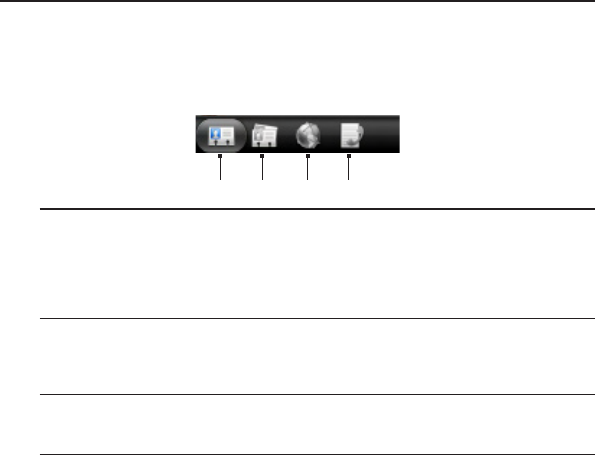
People 77
Facebook See “Adding an account” in the Accounts and sync
chapter for details.
People screen
The People screen gives you easy access to all your contacts, as well
as even faster access to the people and groups of people you contact
most often.
The People screen has the following tabs:
1 2 3 4
1 All tab
Gives you access to all contacts on your phone, including Google
contacts, Exchange ActiveSync contacts, Phone contacts and social
network contacts, such as from Facebook. You can also use this tab to
open or update My contact card. For more information, see “Setting up
My Contact Card” in this chapter.
2 Groups tab
Lets you assign contacts to groups so you can easily send an SMS, MMS,
or email message to a whole group. For more information, see “Contact
groups” in this chapter.
3 Online directories tab
Search for contacts on your online directories such as your Exchange
ActiveSync or Facebook account to copy to your phone.
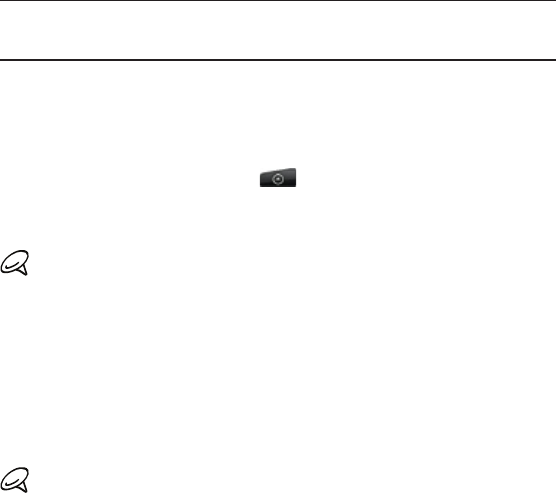
78 People
4 Call history tab
Lists all your dialed numbers and received and missed calls. See “Using
Call History” in the Phone calls chapter.
Setting up My contact card
My contact card provides a convenient way to store your personal
contact information so that you can easily send it via SMS, MMS, email,
or Bluetooth.
From the Home screen, tap > People.
On the All tab of the People screen, tap Me, and then tap Tap
here to edit contact.
If you are logged in to your Facebook account through Facebook
for HTC Sense, instead of Me, you will see your the name you use in
Facebook.
Enter your name and contact details.
Tap Save.
Your contacts list
The All tab of the People screen shows all your contacts, including
Google contacts, Exchange ActiveSync contacts, Phone contacts, and
social network contacts, such as from Facebook.
If you signed in to your Google Account and Facebook account when
you first set up the phone, your contacts from those accounts will
appear in the contacts list when you open People.
1.
2.
1.
2.
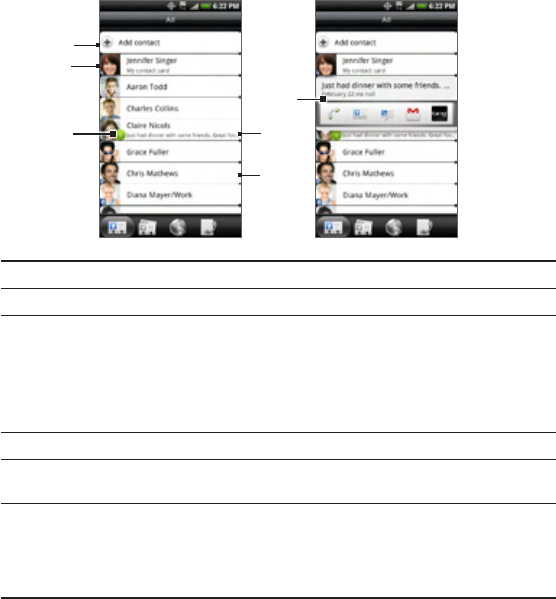
People 79
1
2
3
4
5
6
1 Create a new contact.
2 Tap to edit your My contact card.
3 This icon appears when the contact:
Has sent you a new text or email message, or tried to call you but you
missed the call.
Has updated his or her Facebook profile or has added photos on Flickr
or Facebook.
Has upcoming Facebook events.
4 Tap to open the contact details screen for that contact.
5 This appears when the contact is a Facebook contact or you link the
contact to his or her Facebook account.
6 Tap the photo or icon to open a menu where you can quickly choose how
to communicate with the contact. Depending on the contact information
stored, you can call, send a message or email, see the contact’s Facebook
profile, and map his/her address in Google Maps. The contact’s Facebook
status is also displayed at the top of the options.

80 People
To view only contacts of a particular type, for example Google
contacts or Facebook contacts, press MENU, tap View, and select the
contact types.
Adding a new contact
From the Home screen, tap > People.
On the All tab, tap Add contact at the top of the screen.
Select the Contact type, for example Google or Microsoft
Exchange ActiveSync. This determines which account the
contact will sync with. For more information, see “Ways of
getting contacts into your phone” in this chapter.
Tap the Name field, enter the first and last name of the contact,
and choose the order in which to display the names. Tap OK.
Enter the contact information in the fields provided.
Scroll to the bottom of the screen, and then tap Save.
Importing contacts from an Exchange ActiveSync
account
Access contacts from your Exchange ActiveSync account, and then
copy them to the phone. You need to have your Exchange ActiveSync
account set up on your phone.
From the Home screen, tap > People.
On the Online directories tab, tap Company directory.
Enter the name, and then tap .
In the list, tap the name of the contact you want to copy to your
phone.
Tap Save to People.
1.
2.
3.
4.
5.
6.
1.
2.
3.
4.
5.

People 81
Merging contact information
Merge duplicated contacts on your phone to avoid clutter and
confusion. If you have the same contact appear in your Phone, Google,
and Facebook accounts, you can merge the contact information into
one contact.
The phone automatically merges contacts that it finds to have similar
data. If you need to manually merge contacts or break the link
between contacts, follow the procedures below.
Manually merging contact information
From the Home screen, tap > People.
On the All tab, tap the name of the contact (not the icon or
photo) you want to merge with another contact on your phone.
At the upper right corner of the screen, tap or (if
there are suggested links.)
On the screen, you can:
If there are suggested links, tap to link the contact to
the selected account.
Tap one of the options available in the Add contact section.
Tap Done.
Breaking the contact information link between contacts
From the Home screen, tap > People.
On the All tab, tap the name of the contact (not the icon or
photo) whose contact information link you want to break.
On the upper right corner of the screen, tap .
On the Linked contacts section, tap beside the name of the
contact to break the link.
Tap Done.
1.
2.
3.
4.
5.
1.
2.
3.
4.
5.
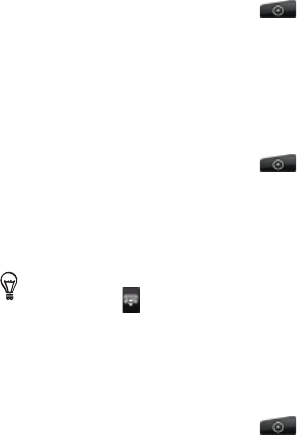
82 People
Editing a contact’s information
From the Home screen, tap > People.
On the All tab, press and hold the contact, and then tap Edit
contact.
Enter the new information for the contact.
Scroll to the bottom of the screen, and then tap Save.
Searching for a contact
From the Home screen, tap > People.
Press the SEARCH button on the phone.
In the search bar, enter the first few letters of the first or last
name of the contact you are looking for. Matching contacts are
displayed.
If the list of matching contacts is long, you can view more results by
tapping to hide the onscreen keyboard.
Tap the contact to open his or her contact details screen. See
“Contact information and conversations” in this chapter for
details.
Backing up your contacts to the storage card
From the Home screen, tap > People.
Press MENU, and then tap Import/Export > Export to SD card.
When asked to confirm, tap OK.
1.
2.
3.
4.
1.
2.
3.
4.
1.
2.
3.
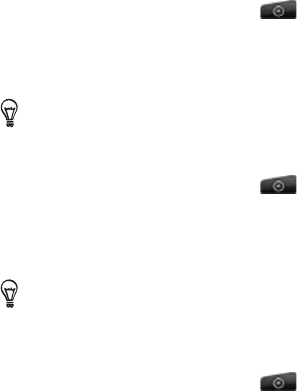
People 83
Importing contacts from the storage card
You can only import contacts that were exported to the storage card
using the Export to SD card feature on the phone. See “Backing up
your contacts to the storage card.
From the Home screen, tap > People.
Press MENU, and then tap Import/Export > Import from SD card.
If you have Google or Exchange ActiveSync accounts set up on
your phone, tap the type for the imported contacts.
Press BACK to stop importing contacts from the storage card.
Deleting contacts
From the Home screen, tap > People.
On the All tab, press MENU, and then tap Delete.
Select the contacts you want to delete, and then tap Delete.
When prompted, tap OK.
To delete a single contact, on the All tab, press and hold the name
of the contact (not the icon or photo) who you want to delete and
select Delete contact from the menu.
Sending contact information as a vCard via MMS
From the Home screen, tap > People.
On the All tab, press and hold the name of the contact (not the
icon or photo) whose contact information you want to send, and
then tap Send contact as vCard.
Select the type of information you want to send, and then tap Send.
Enter the recipient’s number or email address, and then tap Send.
You can also send a vCard via Bluetooth. To learn how to send files
through Bluetooth, see the Bluetooth chapter.
1.
2.
3.
1.
2.
3.
4.
1.
2.
3.
4.
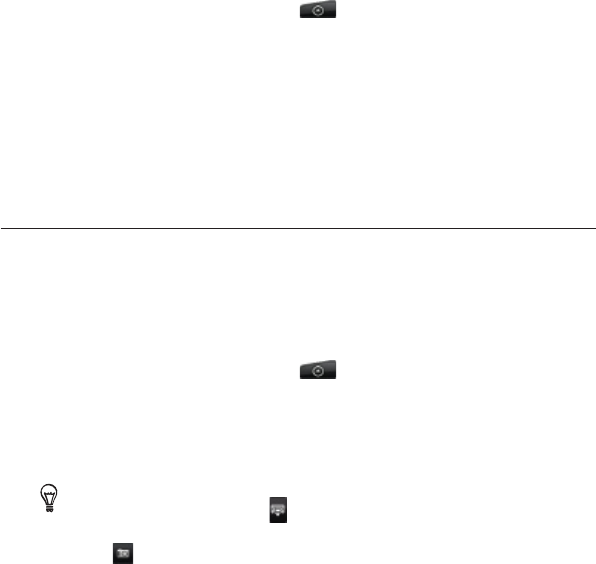
84 People
Sending your contact information as a vCard via MMS
From the Home screen, tap > People.
On the All tab, tap [Your name] My contact card.
Press MENU, and then tap Send my contact info.
Select the type of information you want to send, and then tap Send.
Enter the recipient’s number or email address, and then tap Send.
You can also send your contact vCard via Bluetooth. To learn how to
send files through Bluetooth, see the Bluetooth chapter.
Contact groups
On the Groups tab, you can assign contacts to groups so you can
easily send an SMS, MMS, or email message to a whole group. You
can also sync groups on your phone with the groups in your Google
account, accessible via your computer’s web browser.
Creating a group and adding contacts
From the Home screen, tap > People.
On the Groups tab, at the top of the screen, tap Add group.
Enter a name for the group, and then tap Add contact to group.
Select the contacts you want to add to the group, and then tap
Save.
If your contacts list is long, you can use the search bar to search for
contacts quickly, or tap to hide the onscreen keyboard and scroll
through the list.
Tap to add a group from photo.
Tap Save.
1.
2.
3.
4.
5.
1.
2.
3.
4.
5.
6.
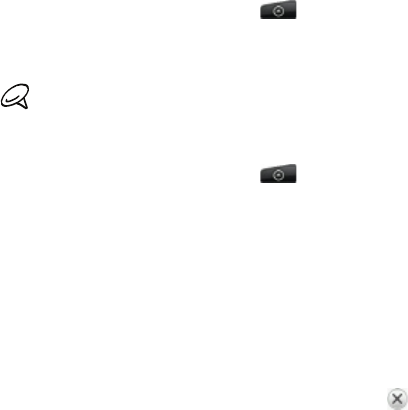
People 85
Deleting a group
From the Home screen, tap > People.
On the Groups tab, press and hold the group you want to delete,
and then tap Delete group.
You can only delete groups that you have created.
Adding or removing contacts from a group
From the Home screen, tap > People.
On the Groups tab, press and hold the group, and then tap Edit
group.
You can:
Tap the group name to change the name. You can only change
the name for groups that you have created.
Tap the icon to the left of the group name to change or
remove the group photo.
To add contacts to the group, tap Add contact to group,
select the contacts you want to add, and then tap Save.
To remove a contact from the group, tap at the right side
of the contact name, and then tap Save.
1.
2.
1.
2.
3.
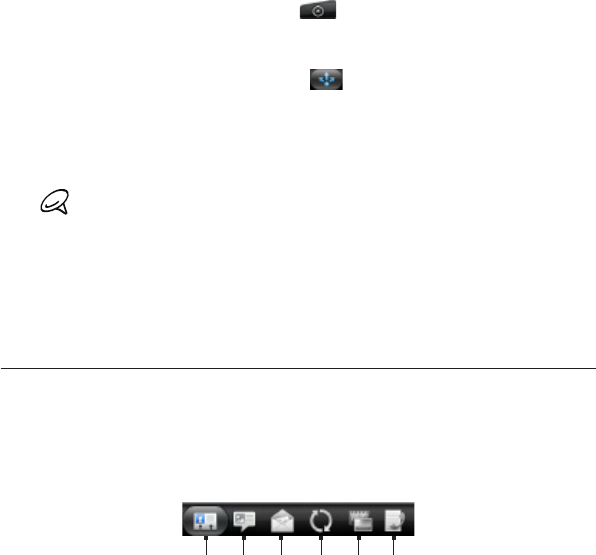
86 People
Sending an SMS/MMS message or email to a group
From the Home screen, tap > People.
On the Groups tab, tap the group you want to send an SMS/MMS
message or email to.
Go to the Group action tab ( ), and then do one of the
following:
Tap Send group message to send an SMS/MMS message to
the group. For information about composing and sending
messages, see the Messages chapter.
You will be charged by your mobile provider for each message sent.
For example, if you send a message to a group of five people, you will
be charged for five messages.
Tap Send group mail to send an email to the group. For
information on composing and sending email, see the Email
chapter.
Contact information and conversations
When you tap a contact on the People screen, the contact details
screen opens, showing you the information stored for that contact,
exchanged messages and phone calls with that contact, Facebook
notifications, and more.
The contact details screen has the following tabs:
65
4
3
2
1
1.
2.
3.

People 87
1 Details tab
Shows the information you have stored for the contact, and allows you
to get in touch with the contact directly by tapping any of the displayed
methods. For example, if the contact has a stored work phone number,
tap Call Work to call that number.
You can also add one of the contact’s phone numbers as a speed dial
number. For information, see “Adding a contact to speed dial” in the
Phone calls chapter.
2 Messages tab
Shows your exchanged SMS messages with the contact. Tap a message
to view it. To send a new message, tap New message. For more
information about messages, see the Messages chapter.
3 Mail tab
Shows email messages you have received from the contact. Tap an email
message to view it. To send a new email message, tap New mail. For
more information about email, see the Email chapter.
4 Updates and events tab
Shows the contact’s Facebook status, updates, and events, shows when
he or she uploads new photos to Flickr, and shows your contact’s tweets
in Twitter. When there is a notification of the contact’s birthday, you
can tap the notification to call the contact directly or send a message
greeting.
You need to be logged in to your Facebook, Flickr, and Twitter accounts
to see the updates and events.
5 Gallery tab
Shows the contact’s Facebook and Flickr photo albums. Tap an album to
look at the photos in the album.
You need to be logged in to your Facebook and Flickr accounts to see
the photo albums. If you are not logged in, tap Link to Facebook and/or
Link to Flickr.
6 Call history tab
Lists all your incoming, outgoing, and missed calls to and from the
contact. Tap a list item to call the contact using the displayed number.

88 People
People widget
Put the group of people you contact most right on the Home screen
of your phone by adding them as the People widget. Using the People
widget, you can instantly place a call, send a message, or view details
of a favorite contact with a single tap.
Adding the People widget
Slide your finger left or right on the Home screen to find the People
widget. If you do not find the People widget on the Home screen,
follow this procedure to add the widget to the Home screen.
From the Home screen, tap > Widget > People.
Choose the widget style, and then tap Select.
Select the group you want to add as a widget.
Drag the widget to a blank space on a Home screen, and then
release.
Setting the default communication method
On the Home screen, go to the People widget.
Tap a contact on the widget.
On the Select default action screen, tap the communication
method you want for the contact.
Changing the default communication method
Tap the contact’s name (not the photo) on the widget.
Press MENU and then tap More > Set widget action.
On the Select default action screen, tap the new communication
method you want for the contact.
1.
2.
3.
4.
1.
2.
3.
1.
2.
3.

People 89
Getting in touch with a contact
On the Home screen, go to the People widget.
Tap a contact (photo not the name) on the widget. The default
communication method will be performed.
Tap the name of the contact to open the contact details screen for
that contact.
If you have not set a default communication method, the
Select default action screen will open. See “Setting the default
communication method” in this chapter for details.
1.
2.
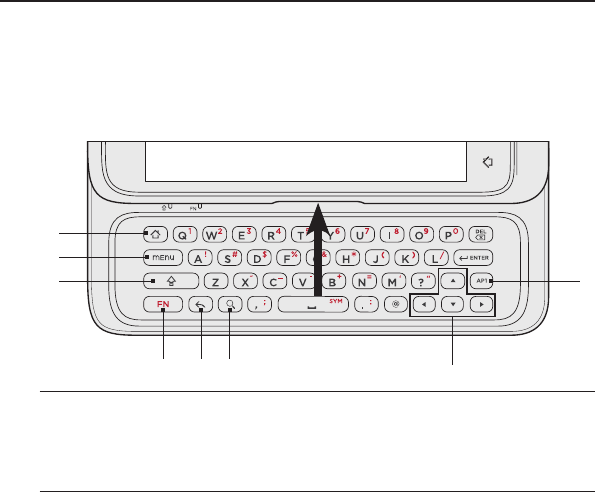
Keyboard
Using the slide-out keyboard
Hold your phone sideways, with the control buttons on the right, and
then push the display up to reveal the slide-out. When you open the
slide-out keyboard your display will always be in landscape and you
will not be able to use the onscreen keyboard.
Open an application that allows text entry, such as Messages, tap a
text box, and then use the slide-out keyboard to enter text.
3
2
654
1
7
8
1 Home key
Instead of pressing the HOME button, press this key to return to the Home
screen (when you’re in an application) or show a snapshot of the extended
Home screens (when you’re in the main Home screen). You can also press
and hold this key to open the recently-used applications window.
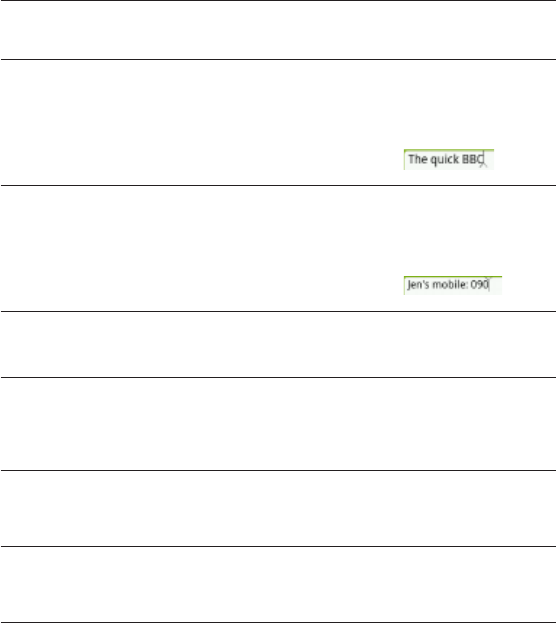
Keyboard 91
2 Menu key
Instead of pressing the MENU button, press this key to open the available
menu options for the current screen.
3 Shift key
Press once and then press a letter key to type that letter in uppercase.
On number or symbol keys, pressing the Shift key causes the special
character to appear.
Lock the Shift key to type a series of characters by pressing Shift twice.
The cursor shape changes while the key is locked:
Unlock the Shift key by pressing it once again.
4 Function (FN) key
Press once to type the character shown in color on some of the keys.
For example, if you need to type the dollar sign ($), press the Shift key
and then press the D key (FN, D).
Press twice to lock the ALT key and type a series of characters.
The cursor shape changes while the key is locked:
Unlock the ALT key by pressing it once again.
5 Back key
Instead of pressing the BACK button, press to go back to the previous
screen, or to close a dialog box, options menu, or the Notifications panel.
6 Search key
Press to open the search box and type anything you want to search.
Press the Enter key to begin the search.
Press this key, and then press a letter key that you’ve assigned to quickly
open an application. See “Opening applications with the keyboard.”
7 Navigation keys
Press these keys to control your direction on the screen, such as when
you’re scrolling up or down on a web page, when you are positioning the
cursor, or when you want to go the next or previous Home screen panel.
8 Shortcut key
This key lets you quickly open an application or an item on your phone
such, as a bookmark. To know how to use the Shortcut key, see “Using the
Shortcut key.”
92 Keyboard
Using the Shortcut key
You can assign the Shortcut key to open an application or an item on
your phone with a single press.
From the Home screen, press MENU, and then tap Settings >
AP1 Shortcut key.
Tap Shortcut key, and then do any of the following:
Tap Apps, and then tap the application that you want to open
every time you press the Shortcut key.
Tap Shortcuts, and then tap the item (such as Bookmark
or Person) that you want to open every time you press the
Shortcut key. Follow the screen instructions to proceed.
3. Open the slide-out keyboard and then press the Shortcut (AP1)
key. The application or item should open.
Opening applications with the keyboard
You can set the keyboard keys to quickly open apps when pressed
together with the Search key. For example, if you’ve assigned the
letter “B” to the phone browser, then wherever you are on your phone,
press Search + B to open the phone browser.
From the Home screen, press MENU, and then tap Settings >
Applications > Quick launch.
Do any of the following:
Tap an unassigned key to create a new app shortcut.
Tap an assigned key to replace it with a new app.
3. Tap the app that you want to assign to the key.
4. Press HOME and then open the slide-out keyboard.and then open the slide-out keyboard.
5. Press and hold the Search key and then press the key you’ve
assigned to open the app.
1.
2.
1.
2.
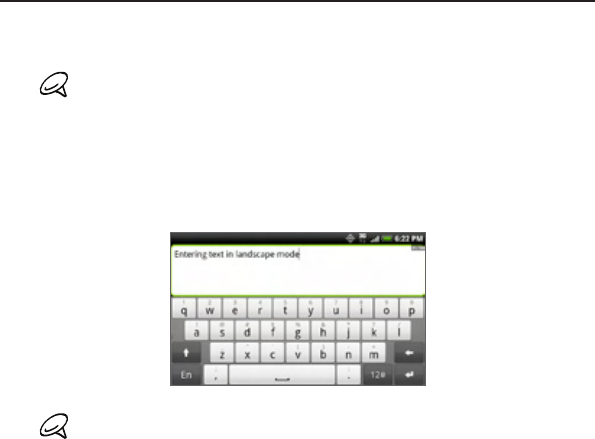
Keyboard 93
Using the onscreen keyboard
When you start a program or select a field that requires text or
numbers, the onscreen keyboard becomes available.
The onscreen keyboard is not available when the slide-out keyboard
is open.
Using the landscape onscreen keyboard
When entering text, you can choose to use the landscape orientation
of the onscreen keyboard. Turn the phone sideways to use a larger
keyboard that lets you type easily using two thumbs.
Select the Auto-rotate screen check box in HOME > MENU >
Settings > Display for the screen orientation to automatically
change.
The landscape orientation keyboard is not supported in all
applications.
94 Keyboard
Changing the onscreen keyboard layout
You can choose from three different keyboard layouts to suit your
typing style. To change the keyboard layout, do the following:
From the Home screen, press MENU, and then tap Settings >
Language & keyboard.
Tap Touch Input > Keyboard types, and then select the keyboard
layout that you want to use. Choose from the following:
QWERTY. This layout is the same with a desktop computer
keyboard. This is the default keyboard layout.
Phone Keypad. This layout is the same with the traditional
mobile phone keypad.
Compact QWERTY. This layout features two letters on each
key. The key size is slightly bigger than on the Full QWERTY
layout.
Changing the keyboard language
You can change the onscreen keyboard layout to a number of
languages that you frequently use.
From the Home screen, press MENU, and then tap Settings >
Language & keyboard.
Tap Touch Input > International keyboard.
Select the languages that you want to switch the onscreen
keyboard to.
Press BACK.
Open an application that accepts text input, such as Messages,
and then tap a text box.
1.
2.
1.
2.
3.
4.
5.
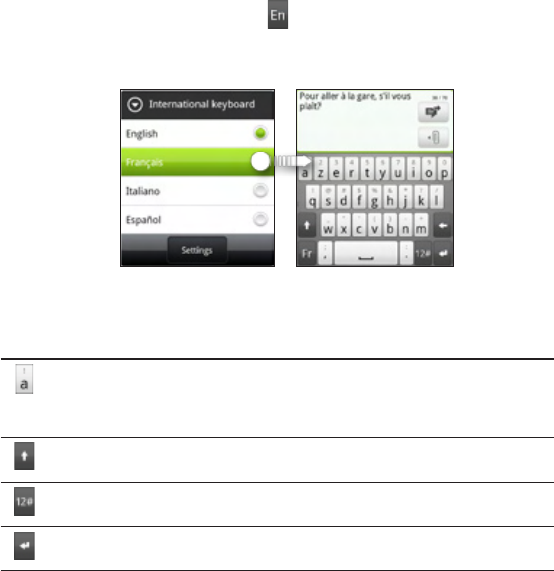
Keyboard 95
Tap the language switch key , and then select the language
that you want to use.
The keyboard layout changes according to your selected
language.
Entering text
Use the following keys while entering text using the onscreen
keyboard:
Press and hold keys with gray characters at the top to enter numbers,
symbols, or accented letters. The gray character displayed on the key
is the character that will be inserted when you press and hold that key.
Some keys have multiple characters or accents associated with them.
This is the Shift key. Tap to enter an uppercase letter. The next letter you
type will be uppercase. Tap twice to turn on caps lock.
Tap to switch to the numeric and symbol keyboard.
This is the Enter key. Tap to create a new line.
6.
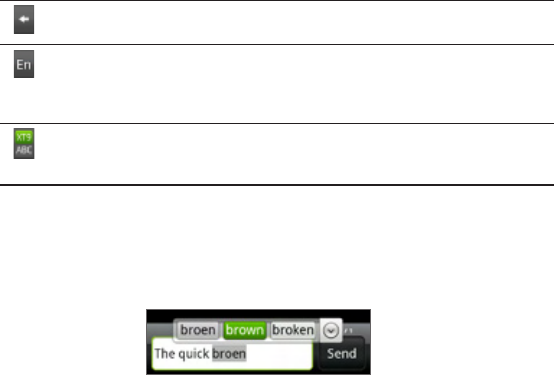
96 Keyboard
This is the Backspace key. Tap to delete the previous character.
Tap to change the onscreen keyboard language.
Tap this key, and then tap Settings to open the Touch Input settings
and change the keyboard type, select the languages you want the
keyboard layout to switch to, and adjust other text input settings.
Tap to toggle between Multitap and XT9 predictive modes when using
the Compact QWERTY or Phone keypad layout. For more information,
see “Entering words with predictive text.”
Entering words with predictive text
The onscreen keyboard has predictive text to help you type quickly
and accurately. Predictive text input is enabled by default, and word
suggestions are displayed as you type.
To enter a word in predictive mode, do any of the following:
If you see the word you want highlighted in green or orange, you
can simply tap the space bar to insert the word into your text.
If you see the word you want shown in the suggestions before
you have finished typing the entire word, tap the word to insert it
into your text.
If an arrow is shown to the right of the suggestion list, tap the
arrow to see more suggestions.

Keyboard 97
Adding a word to the predictive text dictionary
Your phone comes with a list of words that it references for predictive
text suggestions. Sometimes you may need to add a word to the
predictive text dictionary, for example a name or a specialized
technical word.
While entering text using the QWERTY keyboard layout, if you tap any
word on the suggestion list, it is automatically added to the predictive
text dictionary if it was not in the dictionary already.
You can also add a word to the list manually:
On the onscreen keyboard, press .
Tap Settings > User Dictionary.
Tap Add new.
Enter the word to add, and then tap OK.
Editing or deleting a word in the user dictionary
You can edit or remove words that you previously added to the
predictive text dictionary.
On the onscreen keyboard, press .
Tap Settings > User Dictionary.
To edit a word, tap the word itself.
To delete a word, tap the X icon to the right of the word.
1.
2.
3.
4.
1.
2.

98 Keyboard
Adjusting touch input settings
From the Home screen, press MENU, and then tap Settings >
Language & keyboard. > Touch Input.
Touch Input settings
Keyboard types
Tap to select the keyboard layout to use. You can choose from
QWERTY, Phone Keypad, or Compact QWERTY.
International keyboard
Tap to select the language layout of the keyboard.
Text input
Tap to set text input options when entering text, calibrate the
keyboard, and set a sound and/or vibration feedback whenever you
tap a key. See “Text input” for details.
Chinese Text input
Tap to set Chinese text input options. You can enter Chinese
characters using PinYin and Stroke.
Tutorial
Learn how to use the onscreen keyboard with this interactive tutorial.
Keyboard 99
User Dictionary
Add, edit or remove words in the predictive text dictionary. See
“Entering words with predictive text” in this chapter for more
information.
Text input
QWERTY/Hardware QWERTY
Prediction
Select to enable the word prediction feature which provides a list of
possible words that reflect the characters of the keys you have tapped
as well as characters of nearby keys.
Spell correction
Select to correct typographical errors by selecting from a list of
possible words that reflect the characters of the keys you have tapped
as well as characters of nearby keys.
Phone keypad & compact QWERTY
Spell correction
Select to correct typographical errors by selecting from a list of
possible words that reflect the characters of the keys you have tapped
as well as characters of nearby keys.
Word completion
When using the Compact QWERTY or Phone keypad, lets you select
from a list of possible combinations based on the characters that
appear on the keys that you tapped.
100 Keyboard
Other settings
Sound feedback
Select to hear a clicking sound whenever you tap a key on the
keyboard.
Vibrate when typing
Select to enable vibration feedback whenever you tap a key on the
keyboard.
Finger touch precision
Calibration tool
Tap to re-calibrate the keyboard touch accuracy. Re-calibrate the
keyboard if you feel that the keyboard keys are not responding
accurately to your taps.
Reset calibration
Tap to reset the calibration back to factory default.
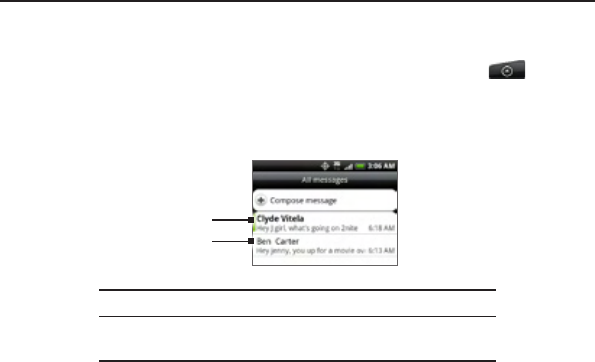
Messages
About Messages
Messages lets you compose and send text (SMS) and multimedia
messages (MMS) to other mobile phones.
To open your message inbox, from the Home screen, tap >
Messages.
If the list of messages does not fit on the screen, you can scroll down
to view more messages by swiping your finger on the screen.
1
2
1 Bold text indicates unread messages in the thread.
2 Tap to open the message or message thread and
read the text or view the picture message.

102 Messages
Sending text and multimedia messages
Send short text messages (SMS) and multimedia messages (MMS)
to other mobile phones. If you exceed the limit on the number of
characters for a single text message, your text message will be
delivered as one but will be billed as more than one message. These
are called concatenated messages.
Multimedia messages can contain text and a picture, a recorded voice,
an audio or video file, a picture slideshow, contact card (vCard), or
appointment (vCalendar).
The Messages application automatically converts a text message into
a multimedia message when you enter an email address in the To
field, add a message subject, attach an item, or compose a very long
message.
Sending a text message
From the Home screen, tap > Messages.
On the All messages screen, tap New message. The Compose
screen opens.
Fill in one or more recipients. You can:
Enter your contact’s name or phone number directly in the
To field. If you’re sending the message to several contacts,
separate the phone numbers with a comma.
As you enter information, any matching contacts or phone
numbers from your contacts list are displayed. Tap a match to
enter that contact or number directly.
Tap the icon, and then select the phone numbers of the
contacts to whom you want to send the message. You can
also select contact groups as recipients.
When you have selected all the message recipients, tap Done.
1.
2.
3.
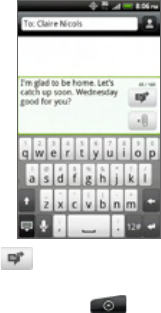
Messages 103
Tap the text box that contains the text “Add text”, and then start
composing your message.
When done, tap to send the text message.
Sending a multimedia (MMS) message
From the Home screen, tap > Messages.
On the All messages screen, tap New message. The Compose
screen opens.
Fill in one or more recipients. You can:
Enter phone numbers or email addresses directly in the To
field. If you’re sending the message to several recipients,
separate the phone numbers or email addresses with a comma.
As you enter information, any matching phone numbers or
addresses from your contacts list are displayed. Tap a match
to enter that number or address directly.
4.
5.
1.
2.
3.
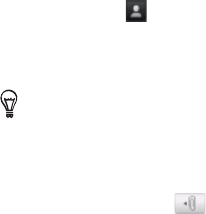
104 Messages
Tap the icon, and then select the contacts to whom you
want to send the message. You can also select contact
groups as recipients. When you have selected all the message
recipients, tap Done.
You can add a subject line by pressing MENU and then tapping Add
subject.
Tap the text box that contains the text “Add text”, and then start
composing your message.
Press MENU and then tap Attach.
You can also tap on the text box and then tap an icon on the
file bar to attach a file to your MMS message.
On the Attach window, select from the following file attachments:
Picture. Select Camera to take a photo and attach it, or
Pictures to attach a photo from your storage card.
Video. Select Camcorder to capture a video and attach it, or
Videos to attach a video from your storage card.
Audio. Select Voice Recorder to make a voice recording and
attach it, or Music & sounds to attach a music file or voice
recording from your storage card.
App recommendation. Choose an application you’ve installed
from Android Market that you want to share with others. The
URL from which the application can be downloaded will be
inserted to your message.
Location. You can attach location information. Send your
current location (requires GPS to be turned on), a location
stored in Footprints, or a location you pick on a map. For more
information about GPS, maps, and Footprints, see the Maps
and location chapter.
4.
5.
6.
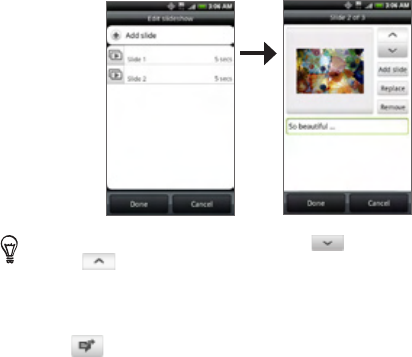
Messages 105
Contact (vCard). Select a contact from your phone, and then
select which contact information you want to attach.
Appointment (vCalendar). Select the calendar event you want
to attach.
Slideshow. Opens the Edit slideshow screen. Tap Add slide to
create a new slide. Tap the created slide (for example, Slide 1),
tap Insert picture, and then select the picture you want to add
to the slide. You can also navigate to the text box and enter a
caption for the picture. When finished, tap Done to attach the
slideshow to your message.
When editing multiple slides, tap to edit the next slide or tap
to return to the previous slide.
While editing the slideshow, press MENU to let you preview the
slideshow, add music or video to a slide, remove a slide, and more.
7. When you have finished composing the multimedia message,
tap .
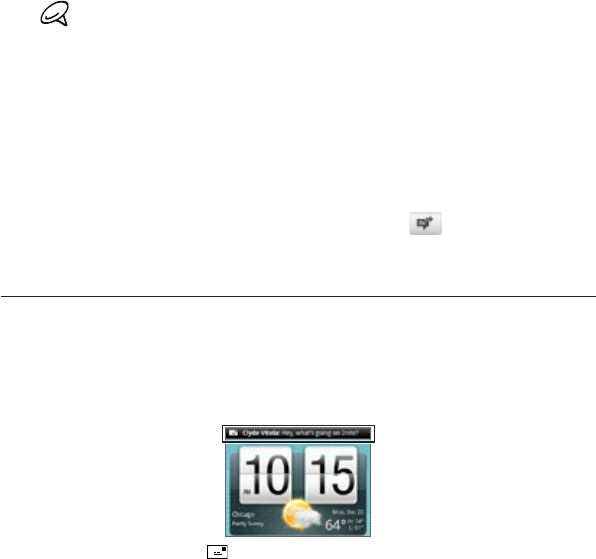
106 Messages
To receive delivery reports and know when a picture message is
received, in the All messages screen, press MENU, and then tap
Settings. Select the Delivery reports check box in the MMS settings
section.
Saving and resuming a draft message
While composing a text or multimedia message, press BACK to
automatically save your message as a draft. To resume composing the
message:
On the All messages screen, press MENU, and then tap Drafts.
Tap the message to resume editing it.
When you finish editing the message, taptap .
New message notifications
Depending on your notification settings, the phone will play a
ringtone, vibrate, or display the message briefly in the status bar
when you receive a new text or multimedia message. To change the
notification for new text and multimedia messages, see “Setting text
and multimedia message options” later in this chapter.
A new message icon also appears in the notifications area of
the status bar to notify you of a new text or multimedia message.
1.
2.
3.
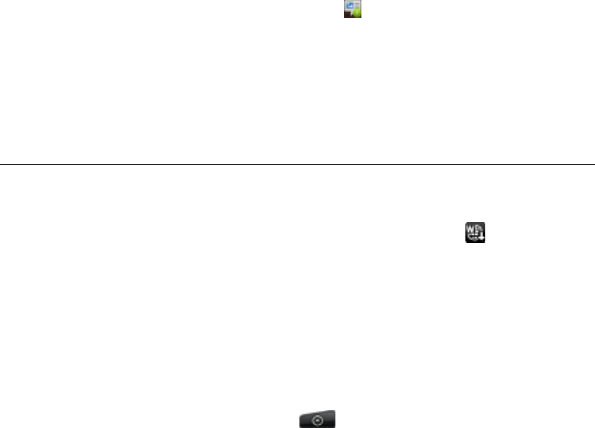
Messages 107
The Messages application icon (if shown on the Home screen) also
displays the number of new messages .
To open the message, press and hold the status bar, and then slide
the status bar down to open the Notifications panel. Tap the new
message to open and read it. For information on reading and replying
to messages see “Managing message conversations” in this chapter.
Viewing push messages
Push messages contain a web link. Often, the link will be to download
a file that you have requested, for example a ringtone.
When you receive a push message, a notification icon is displayed
in the status bar.
Opening the link contained in a push message
Press and hold the status bar, and then slide the status bar down
to open the Notifications panel.
Tap the new message.
Tap Visit website.
Viewing all your push messages
From the Home screen, tap > Messages.
Press MENU, and then tap Push messages.
1.
2.
3.
1.
2.

108 Messages
Managing message conversations
Text and multimedia messages that are sent to and received from a
contact (or a number) are grouped into conversations or message
threads in the All messages screen. Threaded text or multimedia
messages let you see exchanged messages (similar to a chat program)
with a contact on the screen.
Reading a text message
Do one of the following:
On the All messages screen, tap the text message or message
thread to open and read it.
If you have a new message notification, slide the status bar down
to open the Notifications panel. Tap the new message to open
and read it.
To return to the All messages screen from a text message thread,
press MENU and then tap All messages.
To view the details of a particular message, in the message thread,
press and hold the message to open the options menu, and then
tap View message details.
If a message contains a link to a web page, tap the message and
then tap the link to open it in the web browser.
If a message contains a phone number, tap the message and
then tap the phone number to dial the number or add it to your
contacts.
Viewing a multimedia message
From the Home screen, tap > Messages.
On the All messages screen, tap a multimedia message or
message thread to open it.
1.
2.
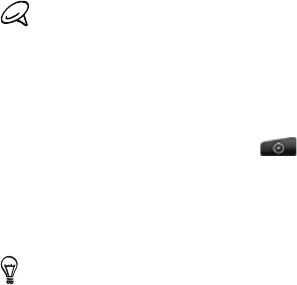
Messages 109
Tap the attachment to open it.
If the attachment is a vCard contact, it is imported to your Phone
contacts list. For information about contacts, see the People
chapter.
If the attachment is a vCalendar file, you can choose the calendar
where you want to save the event. For information on using
Calendar, see the Calendar chapter.
To save the attachment to the storage card, press and hold the
sender’s name or number, and then tap Save [attachment type]
on the options menu.
When Auto-retrieve in MMS settings is disabled, only the message
header is downloaded. To download the entire message, tap the
Download button at the right side of the message. For details, see
“Setting text and multimedia message options” later in this chapter.
If you are concerned about the size of your data downloads, check
the multimedia message size before you download it.
Replying to a text or multimedia message
From the Home screen, tap > Messages.
On the All messages screen, tap a text or multimedia message
thread to open it.
Tap the text box at the bottom of the screen, enter your reply
message, and then tap Send.
To reply to a text message with a multimedia message, open the text
message, press MENU and then tap More > Add subject, or Attach.
The text message is automatically converted into a multimedia
message.
3.
4.
1.
2.
3.
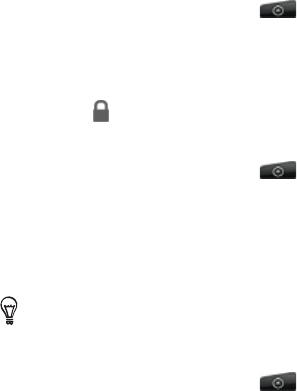
110 Messages
Protecting a message from deletion
You can lock a message so that it will not be deleted even if you
delete the other messages in the conversation.
From the Home screen, tap > Messages.
On the All messages screen, tap a message thread.
Press and hold the message that you want to lock
Tap Lock message on the options menu.
A lock icon is displayed at the right hand side of the message.
Deleting a message thread
From the Home screen, tap > Messages.
On the All messages screen, tap the message thread that you
want to delete.
Press MENU, and then tap Delete.
When prompted to confirm, tap OK.
Any locked messages in the thread will not be deleted unless you
select the Delete locked messages check box.
Deleting several message threads
From the Home screen, tap > Messages.
On the All messages screen, press MENU, and then tap Delete.
Select the message threads you want to delete.
Tap Delete. Any locked messages will not be deleted.
1.
2.
3.
4.
1.
2.
3.
4.
1.
2.
3.
4.

Messages 111
Deleting a single message
While viewing a message thread,
press and hold the message
that you want to delete.
If the message is locked, tap Unlock message on the options
menu, and then press and hold the message to display the
options menu again.
Tap Delete message on the options menu.
When prompted to confirm, tap OK.
Viewing contact details and communicating with a
contact
When you have received a message from someone in your stored
contacts, you can tap the contact’s photo or icon in the message
thread to open a menu of options. Depending on the stored contact
information, you can view the contact details, phone or send an email
message to the contact, and more.
Setting text and multimedia message options
From the Home screen, tap > Messages. On the All messages
screen, press MENU and then tap Settings to set the text or
multimedia message options. You can set the following:
Storage settings
Delete old messages
Automatically delete older messages, except for locked messages,
when the set limits are reached.
1.
2.
3.
4.
112 Messages
Text message limit
Choose the maximum number of text messages to store in each
conversation thread (this does not include locked messages).
Multimedia message limit
Choose the maximum number of MMS messages to store in each
conversation thread (this does not include locked messages).
SMS settings
Delivery reports
Select this option to receive a report on the delivery status of your
message.
Priority setting
Set the message priority of SMS messages sent.
MMS settings
Delivery reports
Select this option to receive a report on the delivery status of your
message.
Auto-retrieve
Select this option to automatically retrieve all your MMS messages
completely. When selected, the MMS message header plus the
message body and attachments will automatically download to your
phone. If you clear this check box, only the MMS message header will
be retrieved and shown in your All messages screen.
Messages 113
Roaming auto-retrieve
Automatically retrieve all your MMS messages completely when
roaming. This may incur significant phone charges.
Priority setting
Set the message priority of MMS messages sent.
Maximum message size
Set the maximum file size of an MMS message. The MMS message will
not be sent out if it exceeds the file size set here.
Received messages
Received notification
Select this option if you want to receive a notification in the status bar
when a new text or multimedia message arrives.
Play notification sound
If you want the phone to ring when a new message arrives, select this
option.
Notification sound
Select a ringtone that is specific to new text and multimedia
messages. Note that the ringtone briefly plays when selected.
Vibrate
Select this option if you want the phone to vibrate when a new text or
multimedia message arrives.

114 Messages
Sent messages
Sent notification
Select this option if you want to receive a notification in the status bar
when a message is sent successfully.
Failure notification
Select this option if you want to receive a notification in the status bar
when a message failed to send.
Play notification sound
If you want the phone to ring when a sent or failure notification is
received, select this option.
Notification sound
Select a ringtone that is specific to sent or failure notifications. Note
that the ringtone briefly plays when selected.
Vibrate
Select this option if you want the phone to vibrate when a new text or
multimedia message arrives.
Adding the Messages widget
Add the Messages widget to let you read your messages on the Home
screen. To learn how to add widgets, refer to “Adding a widget to your
Home screen” in the Personalizing chapter.
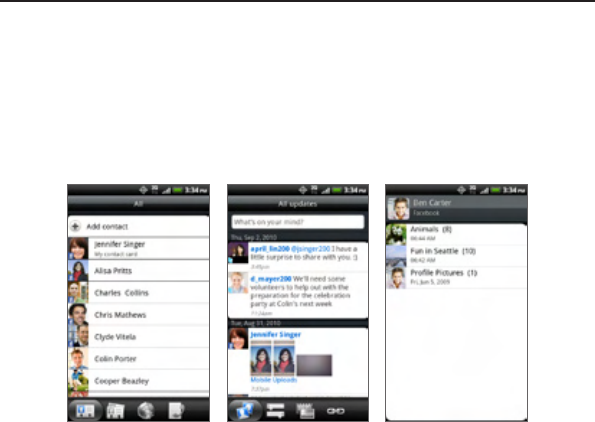
Social
Facebook for HTC Sense and Facebook for
Android application
Facebook for HTC Sense
View your Facebook® updates in supported applications on the phone.
By signing in to Facebook for HTC Sense, your Facebook contacts
and their contact details are downloaded to People, you can browse
through Facebook photo albums in Gallery, and read Facebook status
updates in Friend Stream. To learn how to sign in to Facebook for HTC
Sense, see the Accounts and sync chapter.
People GalleryFriend Stream

116 Social
Facebook for Android application
The Facebook application on your phone lets you keep up and stay
close with your friends in Facebook. It offers most of the features that
you are familiar with when using Facebook on your computer.
If you have more than one Facebook account, you can sign in to the
Facebook application using your other Facebook account.
Using the Facebook application
From the Home screen, tap > Facebook.
If this is your first time to use Facebook, follow the onscreen
instructions to sign in to your Facebook account.
On the News Feed screen, press MENU, and then tap Home to
access the other functions.
While on the Facebook home screen, press MENU, and then tap
Settings to set refresh and notification options.
On some Facebook screens, you can press and hold an item to
open an options menu.
With the Facebook application, you can:
Share your thoughts and check other people’s status updates.
View your friends list and write on someone’s wall.
Comment on a friend’s post.
View someone’s personal information, including photo albums.
Check your Facebook notifications.
Take a photo and upload it straight to your Facebook account.
Adding the Facebook widget
Add the Facebook widget to the Home screen to let you quickly share
your thoughts and view your friends’ status updates.
1.
2.
3.

Social 117
The widget will only link to the Facebook account that you logged
into on the Facebook application.
From the Home screen, tap > Widget > Facebook.
Choose the widget style, and then tap Select.
Drag the widget to a blank space on the Home screen, and then
release.
Differences between Facebook for HTC Sense and
Facebook for Android application
Facebook for HTC Sense is not a standalone application. It is
integrated into People, Friend Stream, and Gallery to give you
up-to-date information about your Facebook contacts (their
status updates and new photos) in these applications.
The Facebook for Android application is a standalone application.
Use this application to do most of the things that you would do
when you’re using your computer’s web browser to access your
Facebook account, such as adding a friend and adding captions
to photos you upload.
The two do not share the same login credentials. Signing in to
Facebook for HTC Sense does not sign you in to the Facebook
application and vice versa. If you want to use the same Facebook
account for both, you’ll have to sign in to both using the same
login credentials.
1.
2.
3.
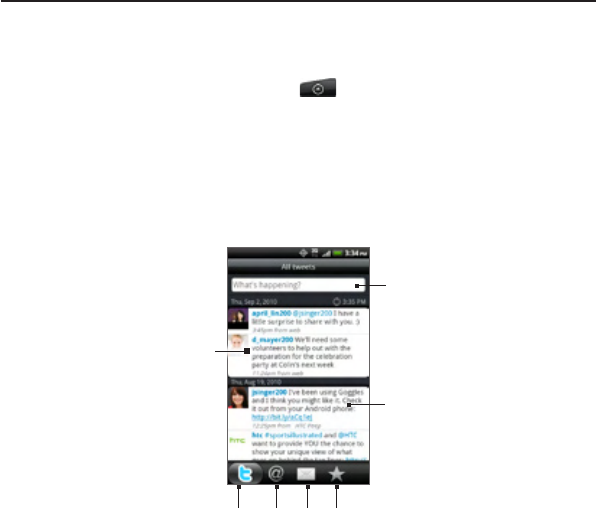
118 Social
Tweeting on your phone
Peep is a Twitter™ client that lets you enjoy “tweeting’’ on your phone.
Send out tweets, read and receive tweets from people, search for new
Twitter users to follow, all from your phone.
From the Home screen, tap > Peep.
If you did not sign in to your Twitter account when you first
turned on the phone, follow the onscreen instructions to sign in
to your Twitter account.
Peep opens in the All Tweets tab. Slide your finger on the bottom
row to go to the tab you want.
Peep screen
2
3
4
1
5 6 7
1.
2.
3.
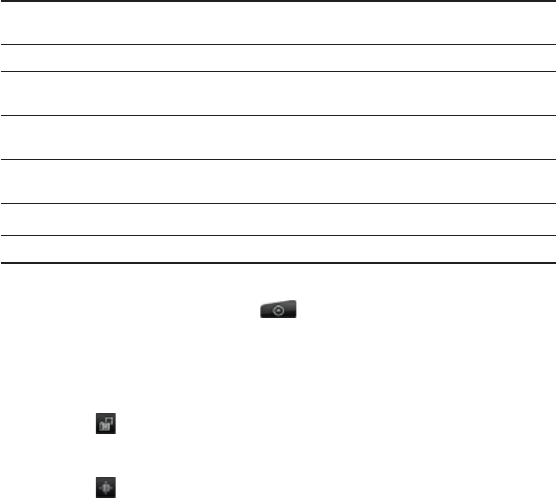
Social 119
1 Tap to view the Twitter user’s profile. This also shows you all tweets from
this Twitter user.
2 Tap to enter a tweet to send out.
3 Press and hold to open the options menu to let you reply, send a direct
message, retweet, add to favorite, and view the profile.
4 Shows all the tweets from people you follow and tweets that you have
sent out.
5 Shows all tweets that mentions your username using the “@[your
username]” convention.
6 Shows all private/direct messages that you have received or sent out.
7 Shows tweets that were marked as favorites.
Sending a tweet
From the Home screen, tap > Peep.
On the All Tweets tab, tap the text field with the words “What’s
happening?”.
Enter your tweet, and then tap Update. Before tapping Update,
you can:
Tap to post a picture from Gallery or Camera to your
default photo hosting site and add the link to the picture into
the tweet.
Tap to insert your location into the tweet. You can choose
to add a map link, insert your location name, or insert your
position coordinates.
1.
2.
3.

120 Social
Searching for Twitter users to follow
From the Home screen, tap > Peep.
While on the Peep screen, press the SEARCH button.
Tap the text field with the words “Search Twitter”, enter the search
criteria, and then tap .
On the Search result screen, scroll through the list, and then tap
the twitter user you want to follow.
The search results will also list down tweets that contain the search
word.
Press MENU, and then tap Follow.
Unfollowing a Twitter user
From the Home screen, tap > Peep.
On the All Tweets tab, tap Twitter user you want to stop
following.
Press MENU, and then tap Unfollow.
Sending a direct message
You can only send a direct message to someone who is following you.
From the Home screen, tap > Peep.
Press MENU, and then tap New message.
You can also send a direct message from the All Tweets or Direct
Message tab. On the All Tweets or Direct Message tab, press and hold
the person you want to send the direct message to, and then tap
Send direct message on the options menu.
1.
2.
3.
4.
5.
1.
2.
3.
1.
2.

Social 121
Tap the To field, and then enter the name. As you enter characters,
the names of the Twitter users that match the characters you enter
will appear. Tap the name when you see it.
Enter your message, and then tap Update.
Setting Peep options
From the Home screen, tap > Peep.
Press MENU, and then tap More > Settings. You can set these
options:
Account settings
Sign out of your Twitter account.
General settings
Choose whether to show the screen name or the real name of the
people you follow.
Send & receive
Set the frequency to check for new tweets and set the number of
tweets to download.
Services
Set your photo hosting site, photo quality, location options, and URL
shortening host.
Notification settings
Select when to be notified and how you want to be notified.
3.
4.
1.
2.

122 Social
Adding the Twitter widget
Add the Twitter widget to let you send and follow your tweets right
on the Home screen.
From the Home screen, tap > Widget > Twitter.
Choose the widget style, and then tap Select.
Drag the widget to a blank space on the Home screen, and then
release.
Twitter
for HTC Sense
View your tweets in supported applications on the phone. By signing
in to Twitter (in Peep or Friend Stream), tweets from your contacts
whom you follow in Twitter are downloaded to the Updates and
events tab of the Contact details screen in People.
Using Friend Stream
Friend Stream connects you to your social networks. Share and get
updates from your Facebook, Twitter, and Flickr accounts on your
phone. With Friend Stream, you can easily track your friends’ status
messages, photo uploads, and web links - or comment and post your
own.
From the Home screen, tap > Friend Stream.
If you are not signed in to a social network account, press MENU,
tap Settings > Accounts & sync, and then tap the account you
want to sign in to.
Friend Stream opens in the All Updates tab. Slide your finger on
the bottom row to go to the tab you want.
1.
2.
3.
1.
2.
3.
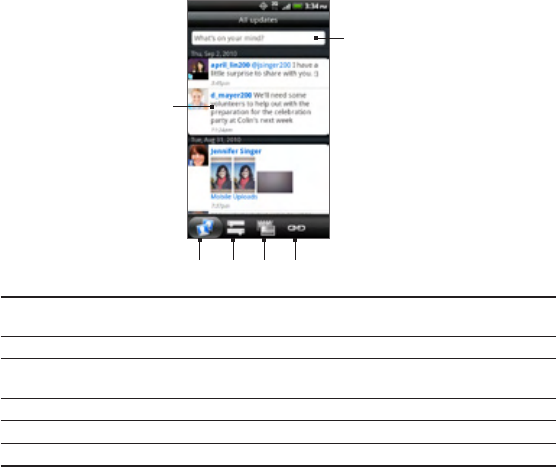
Social 123
Friend Stream screen
Only updates from accounts that you are signed in to will be shown.
You can filter the updates that show in Friend Stream by pressing
MENU, and then tapping Settings > Show updates.
2
3 4 56
1
1 Depending on the type, tap to open Peep, post a Facebook comment,
look at the Flickr album, or open the link in the web browser.
2 Tap to enter and send a status update.
3 Shows all the messages from the social network accounts that you are
signed in to.
4 Shows only status updates from Facebook and Twitter.
5 Shows only photo updates from Facebook and Flickr.
6 Shows only links posted on Facebook.
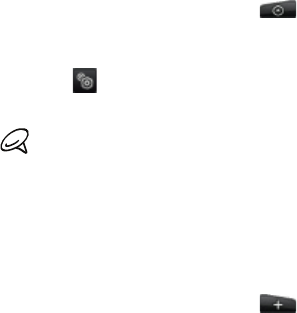
124 Social
Updating your status
From the Home screen, tap > Friend Stream.
On the All Updates tab, tap the text field with the words “What’s
on your mind?”.
Tap , and then on the Update Status dialog box, select which
accounts you want the status update to be posted. Tap Done.
Only the accounts that you are signed in to will be shown on the
dialog box.
Enter your status update, and then tap Share.
Adding the Friend Stream widget
Add the Friend Stream widget so you can update your status
simultaneously and view status updates from your social network
accounts right on the Home screen.
From the Home screen, tap > Widget > Friend Stream.
Choose the widget style, and then tap Select.
Drag the widget to a blank space on the Home screen, and then
release.
1.
2.
3.
4.
1.
2.
3.

Social 125
Chatting in Google Talk
Google Talk is Google’s instant messaging program. It lets you
communicate with other people that also use Google Talk.
This app will auto update when there’s a compatible newer version
available in Android Market.
Signing in to Google Talk
If you signed in to your Google Account when you first set up the
phone, you are already signed in to Google Talk.
From the Home screen, tap > Talk > Next > Sign in.
Enter your Google Account username and password, and then
tap Sign in.
When you are signed in to Google Talk, your online status in Google
Talk will also appear in other Google Apps such as Gmail.
Signing out of Google Talk
If you are not going to use Google Talk for an extended period of
time, we recommend that you sign out of Google Talk to save battery
power.
From the Home screen, tap > Talk.
In the Friends list, press MENU, and then tap More > Sign out.
Chatting with friends
Starting a chat
From the Home screen, tap > Talk.
Tap a friend in the Friends list.
1.
2.
1.
2.
1.
2.

126 Social
Chat with your friend by entering text in the text box at the
bottom of the screen.
To insert a smiley, press MENU, and then tap More > Insert smiley.
Tap a smiley to insert it into your message.
After entering your message, tap Send.
Accepting an invitation to chat
When a friend sends you a Google Talk message, you receive a
notification. Their entry in the Friends list turns white and displays the
message.
Do one of the following:
In the Friends list, tap the friend who sent you the invitation to
chat.
Open the Notifications panel, and then tap the chat notification.
See “Opening the Notifications panel” in the Basic chapter to
learn how to open the Notifications panel.
Returning to the Friends list
While on a chat screen, press MENU, and then tap Friends list.
Switching between active chats
You can switch between chats if you have more than one chat going.
While on a chat screen, press MENU, and then tap Switch chats.
On the screen that opens, tap the friend you want to chat with.
Inviting a friend to join a group chat
While on a chat screen, press MENU, and then tap Add to chat.
Tap the friend you want to invite. The friend you invited and the
current participants receive an invitation to a group chat. Each
one who accepts the invitation joins the group chat.
3.
4.
1.
2.
1.
2.

Social 127
Chatting on or off the record
Your Google Talk messages are stored, so you can review them later and
even search for them in the Chats folder in Gmail. But, if you’d rather not
store the messages in a chat, you can go off the record.
On a chat screen, press MENU, and then tap Chat off record.
To resume saving the messages in the chat, press MENU, and
then tap Chat on record.
Ending a chat
Do one of the following:
In the Friends list, press and hold the friend you want to stop
chatting with, and then in the menu that opens, tap End chat.
While on a chat screen, press MENU, and then tap End chat.
Changing your online status and picture
Changing your online status
From the Home screen, tap > Talk.
In the Friends list, tap the online status icon ( ) beside your
name, and then select the status you want on the options menu.
In addition to the standard status settings described in the table, you
can also select a message that you’ve entered previously. Or tap Clear
custom messages to erase them and start over.
Your status and any message appear in your contact’s Friends lists and
in other locations where your status or status message are displayed.
Changing your status message
From the Home screen, tap > Talk.
In the Friends list, tap the text box to the left of your online
status icon, and then enter your status message.
On the onscreen keyboard, tap .
1.
2.
1.
2.
1.
2.
3.

128 Social
Changing your picture
From the Home screen, tap > Talk.
In the Friends list, tap the picture to the left of your status
message.
In the Select an album screen, tap the album where the picture
you want to use is located.
Tap the picture you want to use.
Drag the green box to select the portion of the picture to crop,
and then tap Save.
Managing your Friends list
Adding a friend
You can invite anyone with a Google Account to become your friend
in Google Talk, so you can chat with each other and view each others’
online status.
From the Home screen, tap > Talk.
In the Friends list, press MENU and then tap Add friend.
Enter the Google Talk instant messaging ID or Google email
address of the friend you want to add.
Accepting an invitation to become a friend
When a contact invites you to become a friend in Google Talk, you
receive a notification in the Status bar and the invitation appears in
your Friends list.
From the Home screen, tap > Talk.
In the Friends list, tap Chat invitation.
1.
2.
3.
4.
5.
1.
2.
3.
1.
2.

Social 129
Do one of the following:
Tap Accept in the menu that opens to accept the invitation.
Tap Cancel if you don’t want to chat with and share your
Google Talk status with the sender.
Viewing the list of pending invitations to friends
From the Home screen, tap > Talk.
In the Friends list, press MENU, and then tap Invites. All the friends
to whom you’ve extended invitations to become friends on Google
Talk appear in the list until they accept or cancel your invitation.
Tap a pending invitation, and then tap Accept or Decline.
Viewing all friends or only those most popular with you
By default, only the friends that you frequently chat with — the most
popular — are shown in the Friends list. But you can view all friends
instead.
From the Home screen, tap > Talk.
In the Friends list, press MENU, and then tap All friends. To switch
back to just the friends with whom you chat most frequently, tap
Most popular in the menu.
Making a friend popular
From the Home screen, tap > Talk.
In the Friends list, press and hold a friend’s name.
If you cannot see the friend, press MENU, and then tap All friends.
In the options menu, tap Always show friend.
3.
1.
2.
3.
1.
2.
1.
2.
3.

130 Social
Blocking a friend
You can block a friend from sending you messages. When blocked,
your friend is also removed from your Friends list.
From the Home screen, tap > Talk.
In the Friends list, press and hold the friend’s name you want to
block.
If you cannot see the friend, press MENU, and then tap All friends.
In the options menu, tap Block friend. Your friend is removed
from your friends list and is added to the blocked friends list.
To unblock a friend, in the Friends list, press MENU and then tap
Blocked. In the Blocked friends list, tap the name of the friend you
want to unblock, and then tap OK when prompted.
Changing Google Talk settings
Setting notifications for new Google Talk messages
You can set the phone to play a sound, vibrate, or display a
notification icon in the status bar each time you receive a new instant
message.
From the Home screen, tap > Talk.
In the Friends list, press MENU and then tap More > Settings.
Select the IM notifications check box to receive a notification
( ) in the status bar when a new instant message arrives.
1.
2.
3.
1.
2.
3.
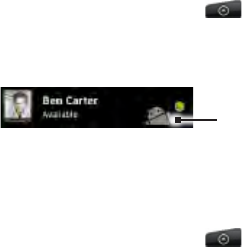
Social 131
Do one of the following:
Tap Select ringtone to select the ringtone to use when a
new instant message arrives. The ringtone briefly plays when
selected. If you don’t want a ringtone to play when you receive
a new Google Talk message, select Silent.
Select the Vibrate check box to vibrate your phone when you
receive a new Google Talk message.
Showing or hiding the mobile indicator to friends
You can check what type of device your friend is using to chat in
Google Talk. In the friends list, check the image that appears to the
right of your friend’s name.
From the Home screen, tap > Talk.
In the Friends list, press MENU, and then tap More > Settings.
Select the Mobile indicator option.
Indicates that the friend is
using an Android phone.
Setting whether you sign into Google Talk automatically
You can sign in to your Google Talk account automatically every time
you turn on your phone.
From the Home screen, tap > Talk.
In the Friends list, press MENU, and tap More > Settings.
Select the Automatically sign in check box.
4.
1.
2.
3.
1.
2.
3.

Accounts and sync
Synchronizing with online accounts
Your phone can sync information and receive updates from your
Google™ and Microsoft® Exchange ActiveSync® accounts as well as
popular online services such as Facebook®, Twitter™, and Flickr®.
These are some of the types of information you can sync:
Gmail™ and Exchange ActiveSync email.
Google and Exchange ActiveSync contacts, as well as your
Facebook friends’ contact information. For information on
contacts, see the People chapter.
Calendar events from your primary Google Account and from
Exchange ActiveSync. For information on using Calendar, see the
Calendar chapter.
Status updates and links shared by your friends and yourself on
social networks such as Facebook and Twitter. For details, see
the Social chapter.
Flickr and Facebook photo uploads. For information on viewing
photos, see the Gallery chapter.
Accounts and sync 133
Adding a social network account
You can sync with your accounts on popular online services such as
Facebook, Twitter, and Flickr.
From the Home screen, press MENU, and then tap Settings >
Accounts & sync.
Tap Add account, and then tap the account type you want to
add.
Follow the onscreen instructions to enter the account
information.
When you have finished, the account is added to the list on the
Accounts & sync screen. Depending on how you configured the
account, the new information may start synchronizing with your
phone.
Synchronizing with a Google Account
Signing in to your Google Account lets you synchronize Gmail and
your Google contacts and calendars between your phone and the
web. You also need to sign in to a Google Account to use Google
applications such as Google Talk™ and Android Market.
You can add more than one Google Account on your phone. However,
subsequent Google Accounts can only synchronize Gmail and
contacts. Other Google services use the first Google Account you
added.
From the Home screen, press MENU, and then tap Settings >
Accounts & sync.
Tap Add account > Google.
Follow the onscreen instructions to sign in to an account or
create a new account.
1.
2.
3.
1.
2.
3.

134 Accounts and sync
Synchronizing with a Microsoft Exchange ActiveSync
account
You can only add one Microsoft Exchange ActiveSync account on
your phone. You can sync with Microsoft Exchange Server 2003
Service Pack 2 (SP2) or later.
From the Home screen, press MENU, and then tap Settings >
Accounts & sync.
Tap Add account > Exchange ActiveSync.
Enter the Exchange ActiveSync account details, and then tap Next.
Your corporate Exchange Server must support auto-detect for
the phone to automatically set up the Exchange ActiveSync
account. If your corporate Exchange Server does not support
auto-detect, you will need to enter your Exchange Server settings
after you tap Next. Ask your Exchange Server administrator for
details.
Select the types of information you want to synchronize, and
then tap Finish setup.
Managing your accounts
Changing general sync settings
From the Home screen, press MENU, and then tap Settings >
Accounts & sync.
Select or clear the following:
Background data. If this is selected, applications can send
and receive online account information even if you are not
currently using them.
1.
2.
3.
4.
1.
2.

Accounts and sync 135
Auto-sync. If this is selected, applications can use the sync
schedule defined in the account settings. If this is cleared, you
will need to sync accounts manually. For instructions on doing
this, see “Synchronizing an account manually”.
Changing account settings
You can change settings such as the sync frequency and the types of
information synchronized, the kinds of notification you receive, and the
way that account information is displayed.
From the Home screen, press MENU, and then tap Settings >
Accounts & sync.
Tap the account that you want to edit.
Edit the account settings.
Synchronizing an account manually
From the Home screen, press MENU, and then tap Settings >
Accounts & sync.
Tap the account that you want to sync.
Tap Sync now.
Removing an account
You can remove an account to delete it and all information associated
with it from your phone, for example messages, contacts, or settings.
Removing an account does not delete information from the online
service itself.
You cannot remove some accounts, such the first Google Account
you signed into on the phone, except by deleting all personal
information from your phone with a hard reset. For instructions on
doing this, see “Performing a hard/factory reset” in the Backup,
update and reset chapter.
1.
2.
3.
1.
2.
3.

136 Accounts and sync
From the Home screen, press MENU, and then tap Settings >
Accounts & sync.
Tap the account that you want to remove.
Tap Remove account, and then confirm that you want to remove
the account.
Synchronizing with your computer
You have your new vacation photos on your phone while your
business calendar is on your computer. Why not make these types of
files and information available on both devices? With HTC Sync™, you
can:
Sync your contacts between your Microsoft® Outlook®, Outlook®
Express or Windows Contacts on your computer and your phone.
Sync your calendar events between the Outlook or Windows
Calendar on your computer and your phone.
Bring your photos, videos, documents, songs, and playlists from
your computer to your phone and enjoy them on the go.
Easily import your captured photos and videos from your phone
to your computer.
Store the same bookmarks on both your computer and phone’s
web browser.
Install third-party mobile phone apps (not downloaded from
Android Market) from your computer.
You need a microSD card inserted into your phone to be able to sync
multimedia files, maps, and documents.
1.
2.
3.

Accounts and sync 137
Installing HTC Sync that came with the microSD card
Make sure the microSD card is inserted to your phone. Copy the HTC
Sync installer from the microSD card to your computer and use it to
install.
HTC Sync can be installed on a computer running Windows 7,
Windows Vista, or Windows XP.
HTC Sync requires USB 2.0 on your computer to connect and sync
with your phone.
For trouble-free installation, first quit all running programs and
temporarily exit from your anti-virus program before you start
installing HTC Sync.
1. Connect your phone to your computer using the supplied USB
cable.
2. On your phone’s Connect to PC screen, tap Disk drive, and then
tap Done.
On your computer, the connected phone is recognized as a
removable disk.
3. Navigate to the removable disk and open it.
4. Copy HTCSync.exe to your computer.
5. After copying, unmount the removable disk (that is, the
connected phone) as required by your computer’s operating
system to safely remove your phone.
6. On your computer, double-click HTCSync.exe and follow the
onscreen instructions to install HTC Sync.
After installing HTC Sync, the HTC Sync icon ( ) is added to
your computer’s system tray (check the bottom-right side of
your computer screen). You can double-click this icon to open
HTC Sync.

138 Accounts and sync
Setting up HTC Sync to recognize your phone
After installing, set up HTC Sync to recognize your phone.
1. Connect your phone to your computer using the supplied USB
cable.
2. On your phone’s Connect to PC screen, tap HTC Sync, and then
tap Done.
On your computer, wait for HTC Sync to recognize your phone.
3. When the Device setup screen opens, enter a name for your
phone.
4. Clicklick Save. The Device panel then opens.The Device panel then opens.
Getting to know the Device panel
On the Device panel, you can set your sync options, see your phone’s
general information, check the used and available space on your
storage card, and begin synchronization.
Click a category of items to see its sync options on the right side
of the Device panel.
You can also click Overview to see your phone’s basic software
information and storage card usage, change the phone name, or
install third-party applications to your phone.
The available categories and options depend on the phone you’ve
connected to your computer.
Click Sync now to start synchronizing the categories and options
you’ve selected.
The estimated storage usage bar beside the Sync now button
shows you the estimated storage card space that will be used
when there are new items to be synchronized and added to your
phone.

Accounts and sync 139
Setting up synchronization
Music
Bring the music tracks and songs you play on your computer to your
phone. If you have playlists created in iTunes® or Windows Media®
Player, you can sync these too and enjoy them on the go.
You can sync audio files in these formats:
*.aac, *.amr, *.m4a, *.mid, *.midi, *.mp3, *.wav, and *.wma.
1. On the Device panel, click Music, and then click the On button.
Turning Music sync on means you want this category included
every time you sync your computer and phone.
2. Select Sync music files from, and then click Add.
3. Choose the folder that contains your audio files, and then click OK.
All supported audio files added to this folder will also be copied
to your phone’s storage card during synchronization.
4. Select Sync music files from iTunes and Windows Media Player if
you’re using any of these apps on your computer. Then, choose
one of the following:
All songs and playlists. Choose to sync all songs and playlists
from iTunes and Windows Media Player.
Selected playlists. Choose to select only your favorite playlist
titles.

140 Accounts and sync
Gallery
You can choose to automatically copy your phone camera shots to
your computer. At the same time, when you select a folder from your
computer, the photos and videos stored in it are also synchronized on
your phone’s storage card.
You can sync photos and videos in these formats:
Photos: *.bmp, *.gif, *.jpeg, *.jpg, and *.png.
Videos: *.3gp, *.3g2, *.mp4, and *.wmv.
On the Device panel, click Gallery, and then click the On button.
Turning Gallery sync on means you want this category included
every time you sync your computer and phone.
2. To automatically import your camera shots to your computer
during synchronization, select Copy device Camera Shots to PC.
Photos and videos from your storage card will be saved to the
\My Photos\Device Camera Shots folder on your computer.
3. Select Sync PC photos & videos from, and then click Add.
4. Choose the folder on your computer that contains your
multimedia files, and then click OK.
All supported image and video files added to this folder will also
be copied to your phone’s storage card during synchronization.
Calendar
Your phone can sync appointments and events with your calendar in
Outlook (Outlook XP, Outlook 2003 or Outlook 2007) or Windows
Calendar (for Windows Vista).
On the Device panel, click Calendar, and then click the On button.
1.
1.

Accounts and sync 141
Turning Calendar sync on means you want this category included
every time you sync your computer and phone.
2. Select the app you want to sync calendar events with.
3. Choose the number of days of calendar events to sync. You can
choose One week ago, Two weeks ago, or One month ago.
4. In cases when conflicting information are found on both the
phone and computer, choose which information you want to
keep.
You can only sync the following calendar event details: Event name,
Event date, Start time, End time, Event location, Description, Reminder,
and Repetition.
People
Sync your phone contacts with your Outlook (Outlook XP, Outlook
2003 or Outlook 2007), Outlook Express, or Windows Contacts (for
Windows Vista).
If you have contacts to sync from your SIM card, you have to import
these first to your phone storage.
1. On the Device panel, click People, and then click the On button.
Turning People sync on means you want this category included
every time you sync your computer and phone.
2. Choose the app you want to sync your contacts with.
3. In cases when conflicting information are found on both the
phone and computer, choose which information you want to
keep.
Only the contact fields supported on your phone will be synchronized.

142 Accounts and sync
Bookmarks
Sync the bookmarks inside the “HTC Bookmarks” favorites folder in
your computer’s web browser with the bookmarks stored on your
phone’s web browser.
1. On the Device panel, click Bookmarks, and then click the On
button.
Turning Bookmarks sync on means you want this category
included every time you sync your computer and phone.
2. Choose the web browser that stores the bookmarks to sync with
your phone.
Only the web page title and URL information are synchronized.
If you are using Firefox® and have selected it to sync with your phone,
make sure to close all Firefox browser windows before you begin
synchronization.
When conflicting information are found on both the phone and
computer, HTC Sync keeps the information from your computer.
Documents
You can sync files and documents from your computer to your phone.
Make sure that your phone has the app needed to open or view such
files and documents.
Usually, your phone can open and view these file types: Microsoft
Office 2003 and 2007 Word (.doc), Excel (.xls), and PowerPoint (.ppt),
PDF files (.pdf), Text files (.txt).
You can also sync email attachments that you stored on your phone’s
storage card to your computer.
To sync email attachments stored on your phone’s storage card to your
computer, you must set up an Exchange ActiveSync or POP3/IMAP
email account on your phone using Mail. See the Email chapter.

Accounts and sync 143
1. On the Device panel, click Documents, and then click the On button.
Turning Documents sync on means you want this category
included every time you sync your computer and phone.
2. To sync email attachments that you’ve stored on your phone’s
storage card, select Copy all download Mail documents to PC.
When you sync the phone with your computer, email
attachments will be saved to the \My Documents\Device
documents\ folder on your computer.
3. To sync files and documents from your computer to your phone’s
storage card, select Sync PC documents from, and then click Add.
4. Choose a folder that contains the files you want to sync with
your phone, and then click OK.
When you sync the phone with your computer, the files and
documents from your computer will be saved to the \My
Documents\Documents\ folder on your phone’s storage card.
Synchronizing your phone
When you are done setting up sychronization for your selected
categories, click the Sync now button.
After synchronization is complete, click Disconnect and safely remove
your phone as required by your computer’s operating system. The
next time you connect your phone to your computer, synchronization
automatically begins based on your sync options.
Always check the estimated file size of new items that you want to
synchronize with your phone. You will see a warning icon beside the
estimated storage usage bar when there isn’t enough space left on your
storage card.
144 Accounts and sync
Installing apps from your computer to your phone
If you have apps (*.apk files) on your computer, you can use HTC Sync
to install them to your phone. We strongly recommend that you install
only those apps that you trust.
Before you begin, make sure that your phone is set to allow app from
your computer to be installed to your phone. To do this, press MENU
from the Home screen, tap Settings > Applications, and then select
the Unknown sources check box.
1. Connect your phone to the computer with the supplied USB cable.
2. On your phone’s Connect to PC screen, tap HTC Sync and then
tap Done.
HTC Sync automatically starts on your computer.
3. On the Device panel of HTC Sync, click Application installer.
4. Locate the app on your computer, and then click Open.
5. Click Done. The installation process starts on your phone.
6. Check your phone’s screen to see if there are additional
instructions to complete the installation.
7. After installation is complete, you can click Disconnect and safely
remove your phone as required by your computer’s operating
system.

Accounts and sync 145
Synchronizing another phone with your computer
HTC Sync can synchronize up to three phones with your computer,
making your favorite music, videos, photos, and files always available
to you.
Make sure that all the phones you connect with your computer and
synchronize using HTC Sync are running on Android 2.1 or later.
1. Connect the other phone to your computer using the supplied
USB cable.
2. On the phone’s Connect to PC screen, tap HTC Sync, and then
tap Done.
3. On your computer, wait for HTC Sync to recognize the other
phone. When the Device setup screen opens, enter a name for
the phone, and then click Save.
4. You can separately customize your sync settings for this phone.
To switch between the connected phones, click Devices on the
top left corner of the Device panel, and then click the phone’s
name or image.

Email
Using Gmail
Gmail is Google’s web-based email service. Gmail is configured when
you first set up your phone. Depending on your synchronization
settings, Gmail on your phone is automatically synchronized with
one or more Gmail accounts on the web. For more information about
synchronization, see “Synchronizing with a Google Account” in the
Accounts and sync chapter.
This app will auto update when there’s a compatible newer version
available in Android Market.
Viewing your Gmail inbox
The Inbox conversations list is your default Gmail view. All your
received email messages are delivered to your Inbox.
Gmail groups each message you send with all the responses you
receive. This conversation list continues to grow as new replies arrive,
so you can always see your messages in context. A new message
or a change to the subject of a current message will begin a new
conversation.
From the Home screen, tap > Gmail.
To scroll through the conversation list, swipe your finger up/down
on the screen.
1.
2.
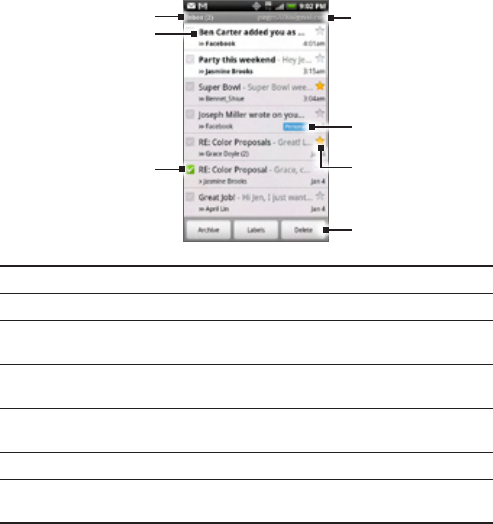
Email 147
6
5
4
7
1
3
2
1 Folder (or Label) and number of unread email messages.
2 Unread messages are displayed in bold.
3 Checked email. Select one or more emails to apply an action.
Note: Batch operations needs to be enabled.
4 Actions for checked email(s). This will not show if there is no
item selected in the inbox.
5 Starred message. Tap to add or remove the star. For more
information, see “Starring a message” in this chapter.
6 Message label
7 The Google Account you are currently viewing. To view another
account, see “Switching to another Google Account”.

148 Email
Switching to another Google Account
If you have set up more than one Google Account on your phone,
you can switch between accounts in Gmail. For more information
on setting up Google Accounts, see “Synchronizing with a Google
Account” in the Accounts and sync chapter.
While viewing the Inbox, clear any checked email messages.
Press MENU, and then tap Accounts.
Tap the account to switch to.
Reading your messages
Depending on your notification settings, the phone plays a ringtone,
vibrates, or displays the email message briefly in the status bar when
you receive a new email. A new email message icon also appears
on the notifications area of the status bar to notify you of a new email.
For more information on email notification settings, refer to “Changing
Gmail settings” later in this chapter.
For information on automatic email synchronization, see “Changing
Gmail synchronization settings” in this chapter.
To refresh your inbox manually, press MENU and then tap Refresh.
1. Do one of the following:
When you receive a new email notification, press and hold the
status bar, and then slide your finger down on the screen to
open the Notifications panel. Tap the new email to view it.
While in the Inbox, tap the unread email or the conversation
with the unread email to view it.
2. To scroll through the messages in the conversation, swipe your
finger up/down on the screen.
1.
2.
3.
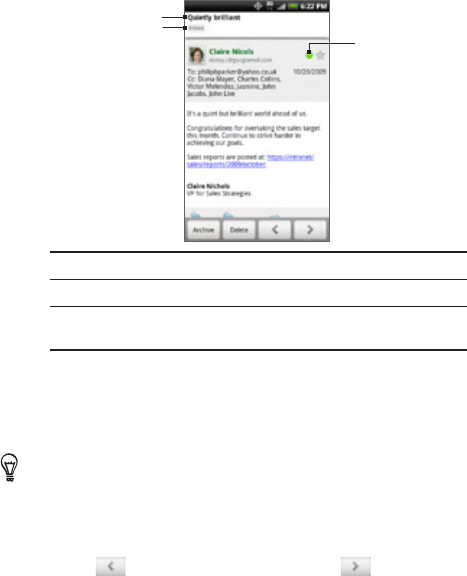
Email 149
3
1
2
1 Message subject.
2 Message label.
3 Online status. Appears when the contact is a Google
Talk friend and you are signed in to Google Talk.
3. To manage the email message or conversation, do any of the
following:
Tap Archive to remove the conversation from your Inbox while
still keeping it stored in your Google Account.
To display your archived messages, in the Inbox, press MENU and
then tap View labels > All Mail.
Tap Delete to delete the conversation from your Google
Account. If you delete the conversation accidentally, you can tap
Undo in the yellow bar at the top of the screen to undelete it.
Tap to see the previous, or tap to see the next
conversation in your Inbox.
Press MENU to see more options.
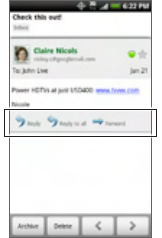
150 Email
Replying to or forwarding an email message
In the message thread, scroll down to the end of the
conversation.
Tap Reply, Reply to all, or Forward.
3. Do one of the following:
If you selected Reply or Reply to all, enter your reply message.
If you selected Forward, specify the message recipients.
4. Tap Send.
Muting a conversation
If you’re part of a long message conversation that isn’t relevant, you can
‘mute’ the conversation to keep all future additions out of your Inbox.
While viewing the message thread, press MENU and then tap More >
Mute.
1.
2.

Email 151
Reporting a conversation as spam
The Gmail webmail service works hard to prevent spam (unwanted
and unsolicited “junk” mail) from reaching your Inbox. But when spam
makes it through, you can help improve the service by reporting the
conversation as spam.
While viewing the message thread, press MENU, and then tap More >
Report spam.
Sending a message
From the Home screen, tap > Gmail.
In the Inbox, press MENU and then tap Compose.
Enter the message recipient’s email address in the To field. If
you are sending the email to several recipients, separate the
email addresses with a comma. You can add as many message
recipients as you want.
As you enter email addresses, any matching addresses from your
contacts list are displayed. Tap a match to enter that address
directly.
If you want to send a carbon copy (Cc) or a blind carbon copy (Bcc)
of the email to other recipients, press MENU and then tap Add Cc/
Bcc.
Enter the email subject, and then compose your email.
If you want to add a picture attachment, press MENU and then
tap Attach. Navigate to the picture you want to attach, and then
tap the picture.
1.
2.
3.
4.
5.
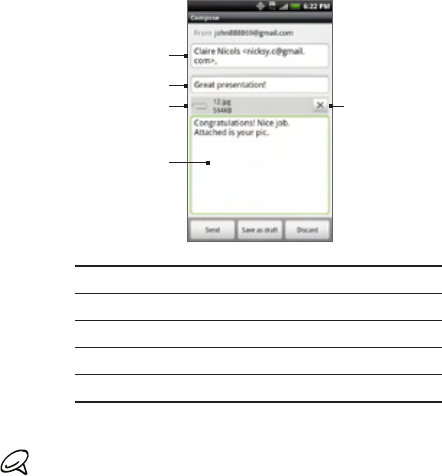
152 Email
4
5
1
2
3
1 Recipient.
2 Subject.
3 Attachment.
4 Enter your message here.
5 Tap to remove the attachment.
After composing your message, tap Send.
While composing the message, tap Save as draft or press BACK to
save it as a draft. To view your draft email messages, in the Inbox,
press MENU and then tap View labels > Drafts.
Adding a signature to your messages
You can add a signature to email messages that you send.
In the Inbox, press MENU and then tap Settings > Signature.
Enter your signature in the text box, and then tap OK.
6.
1.
2.

Email 153
You can create a signature consisting of multiple lines of text. At the
end of each line of text, tap on the onscreen keyboard to create
another line.
Viewing your sent messages
In the Inbox, press MENU and then tap View labels > Sent.
Managing conversations and messages
Searching for messages
You can search for messages that contain one or more words in their
contents or in their addresses, subjects, labels, and so on. When you
search for messages, all of the messages in your Gmail account on the
web are included (except those labeled Trash or Spam), not just those
that you’ve synchronized onto your phone.
In the Inbox, press SEARCH.
Enter the word or words to search for.
Tap , or tap the Enter key on the onscreen keyboard.
A conversation list opens, displaying all of the conversations with
messages that contain the words you searched for. The words
you searched for are displayed in the title bar. You work with the
conversations in this list just as you would with the conversations in
your Inbox or any other conversation list.
Starring a message
You can star an important message so that you can easily find it again.
Conversations with starred messages are displayed with a star in your
Inbox and other conversation lists. To view just conversations with
starred messages, see “Viewing conversations by label” in this chapter.
1.
2.
3.

154 Email
Do one of the following:
While reading a message, touch the star in its header.
When viewing a conversation, touch its star to start the newest
message in the conversation.
To unstar a message, touch its star again. You can also touch a star in
a conversation list to unstar all messages in the conversation.
Labeling a conversation
You can organize conversations by labeling them. Gmail has several
preset labels you can use, and you can also add your own labels, using
Gmail on the web.
While viewing the messages in a conversation, press MENU and
then touch Change labels.
Select the labels that you want to assign to the conversation, and
then tap OK.
Viewing conversations by label
You can view a list of the conversations that have the same label.
When viewing your Inbox or another conversation list, press
MENU, and then touch View labels.
Touch a label to view a list of conversations with that label.
The conversation list resembles your Inbox, but the label replaces
“Inbox” in the title bar. You work with labeled conversations lists in the
same way as with your Inbox.
Changing Gmail synchronization settings
From the Home screen, tap > Gmail.
Press MENU, and then tap Settings > Labels.
To set the number of days to synchronize, tap Number of days to
sync.
1.
2.
1.
2.
1.
2.
3.
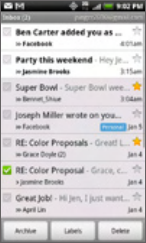
Email 155
To set synchronization for a particular label, tap the label. You
can select to synchronize the default number of days, or you can
sync all or none of the label’s messages.
Working with conversations in batches
You can archive, label, delete, or perform other actions on a batch
of conversations at once, in your Inbox or in another labeled list of
conversations.
In the Inbox or other conversation list, select the check boxes for
the conversations you want to work with as a batch. When you
select a check box, the Archive, Labels, and Delete buttons are
displayed at the bottom of the screen.
Tap the Archive, Labels, or Delete button to perform one of those
actions on the batch of conversations, or press MENU for more
options.
4.
1.
2.

156 Email
Changing Gmail settings
From the Home screen, tap > Gmail.
In the Inbox, press MENU and then tap Settings.
Set the following options:
Signature. Tap to enter a signature that is appended at the
end of your emails.
Confirm actions. Select the check box to show a confirmation
box when you archive or delete a conversation.
Auto-advance. Set which screen opens when you delete
or archive a conversation you are viewing. You can select
from the messages in the next conversation, the previous
conversation, or the Inbox or other conversation list you’re
working with.
Message text size. Select the size of text in the messages you
read.
Batch operations. When selected, this adds a check box to
the left of each conversation so you can add it to a batch. See
“Working with conversations in batches” above.
Clear search history. Remove the searches you have
performed.
Labels. Tap to select how many days and which Gmail labels
to synchronize.
Email notifications. Select the check box to show a notification
icon on the status bar when you receive a new email.
Tap Select ringtone if you want your phone to play a
notification sound when a new email message arrives. On
1.
2.
3.

Email 157
the ringtone menu, select a ringtone specific to new email
messages. The ringtone plays briefly when selected. If you
don’t want a ringtone to play when you receive a new email
message, tap Silent. To confirm your ringtone selection, tap
OK.
Select Vibrate if you want your phone to vibrate when you
receive a new email message.
Notify once. Select to receive a notification from Gmail only
the first time you have new email since you last read your
messages, rather than each time a new message arrives.
Using Mail
The Mail application lets you send and receive email from your
webmail or other accounts, using POP3 or IMAP.
It also lets you access your Exchange ActiveSync email and other
features on your phone. For information on this, see “Exchange
ActiveSync email” in this chapter.
Adding a POP3/IMAP email account
From the Home screen, tap > Mail.
Do one of the following:
If this is your first time to add an email account in Mail, tap
Other (POP3/IMAP) on the Choose a mail provider screen.
If you have already added an email account in Mail, tap
on the upper-left corner, and then tap New Account. If the
Choose a mail provider screen is displayed, tap Other (POP3/
IMAP).
1.
2.
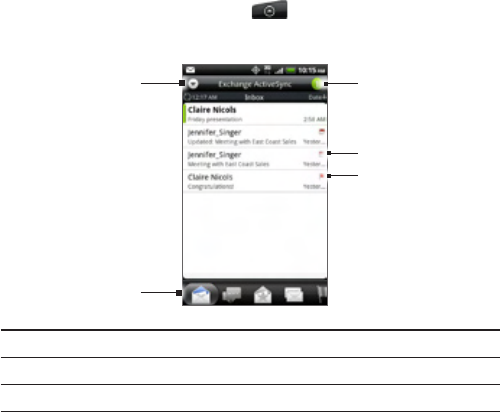
158 Email
Enter the Email address and Password for the email account and
then tap Next.
If the account type you want to set up is not in the phone
database, you will be asked to enter more details.
Enter the Account name and Your name and then tap Finish
setup.
Viewing your email inbox
From the Home screen, tap > Mail.
Tap a tab at the bottom of the screen to filter the inbox.
1
2
3
5
4
1 Tap to view a different email account or add a new email account.
2 Filter tabs. See “Inbox filter tabs” for details.
3 Marked (Exchange ActiveSync only)
3.
4.
1.
2.
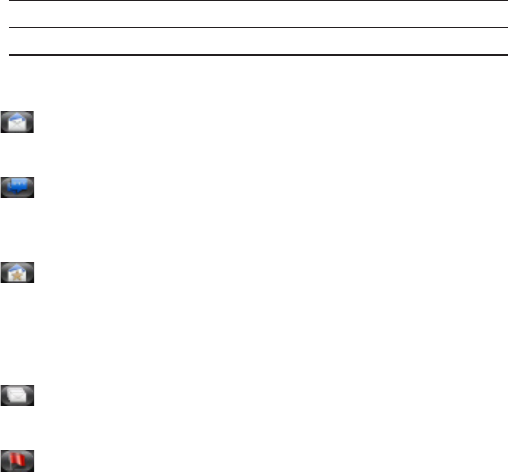
Email 159
4 Meeting invitation (Exchange ActiveSync only)
5 Number of unread email messages.
Inbox filter tabs
Received
Displays email messages as individual items.
Conversations
Displays messages as conversations, grouped according to the subject
line. Tap a subject in the list to show the email conversation.
Favorites
Displays messages from your favorite contacts. To add contacts as
favorites from this tab, tap Add contact to group, select the contacts
you want to add, and then tap Save. For more information on contact
groups, see “Contact groups” in the People chapter.
Unread
Displays unread messages.
Marked (Exchange ActiveSync only)
Displays all flagged messages.

160 Email
Meeting invitations (Exchange ActiveSync only)
Displays meeting invitations which you have not yet accepted or
declined.
Attachments
Displays all messages that have attachments.
Refreshing an email account
Whatever your automatic synchronization settings are, you can also
synchronize your sent and received emails manually at any time.
While in the account you want to synchronize, press MENU, and then
tap Refresh.
Sorting email messages
On the email account Inbox, press MENU, and then tap Sort.
Select from the options to sort email messages by date received,
priority, subject, sender, or size.
Deleting an email message
On the email account Inbox, press and hold the message you
want to delete.
On the options menu, tap Delete.
Deleting multiple email messages
On the email account Inbox, press MENU and then tap Delete.
Select the messages you want to delete, and then tap Delete.
1.
2.
1.
2.
1.
2.

Email 161
Exchange ActiveSync email
If you synchronize your phone with your work Exchange ActiveSync
account, you can read, manage, and send email in the same easy way
as with a POP3/IMAP account. However, you can also access some
powerful Exchange features.
For information on setting up an Exchange ActiveSync account, see
“Synchronizing with a Microsoft Exchange ActiveSync account” in the
Accounts and sync chapter.
Setting out of the office status
You can set your Out of Office status and auto-reply message right
from your phone.
From the Home screen, tap > Mail.
Switch to the Exchange ActiveSync account.
Press MENU and then tap More > Out of the office.
Tap the field below I am currently, and then select Out of the
office.
Set the dates and times for the period when you will be out of
the office.
Enter the auto-reply message.
Tap Save.
Sending a meeting request
From the Home screen, tap > Mail.
Switch to the Exchange ActiveSync account.
Press MENU and then tap More > New meeting invitation.
Enter the meeting details, and then tap Send.
1.
2.
3.
4.
5.
6.
7.
1.
2.
3.
4.

162 Email
Setting the priority for an email message
You can set the priority for an email message you send with your
Exchange ActiveSync account.
While composing the message, press MENU.
Tap Set priority.
Select the priority for the message.
If you selected High or Low priority, the priority appears below the
subject line of the message.
Composing and sending an email message
From the Home screen, tap > Mail.
On the email account Inbox, press MENU and then tap Compose.
Fill in one or more recipients. You can:
Enter email addresses directly in the To field. If you’re sending
the email to several recipients, separate the email addresses
with a comma.
As you enter email addresses, any matching addresses from
your contacts list are displayed. Tap a match to enter that
address directly.
Tap the icon, and then select the contacts to whom you
want to send the message. You can also select contact groups
as recipients, or add contacts from the company directory
if you have set up an Exchange ActiveSync account on your
phone. When you have selected all the message recipients, tap
Done.
If you want to send a carbon copy (Cc) or a blind carbon copy (Bcc)
of the email to other recipients, press MENU, and then tap Show
Cc/Bcc.
1.
2.
3.
1.
2.
3.

Email 163
Enter the subject, and then compose your message.
To add an attachment, press MENU, tap Add attachment, and
choose from the following options:
Picture. Select Camera to take a photo and attach it, or
Pictures to attach a photo from your storage card.
Video. Select Camcorder to capture a video and attach it, or
Videos to attach a video from your storage card.
Audio. Select Voice Recorder to make a voice recording and
attach it, or Files to attach a music file or voice recording from
your storage card.
App recommendation. Choose an application you’ve installed
from Android Market that you want to share with others. The
URL from which the application can be downloaded will be
inserted to your message.
Location. You can attach location information. Send your
current location (requires GPS to be turned on), a location
stored in Footprints, or a location you pick on a map. For more
information about GPS, maps, and Footprints, see the Maps
and location chapter.
Document. Attach a PDF file or an Office document such as a
text file or a spreadsheet.
Tap Send to send the message immediately, or tap Save as draft
if you want to send it later.
To open a draft email, in the email account Inbox, press MENU, and
then tap Folders > Drafts.
4.
5.
6.
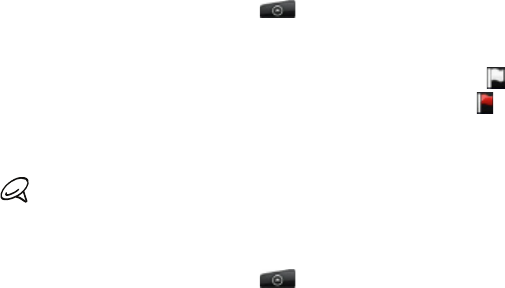
164 Email
Viewing and replying to an email message
From the Home screen, tap > Mail.
On the email account Inbox, tap the email you want to view.
For an Exchange ActiveSync account, you can mark an email. To
mark an email, while viewing an email, tap the white flag on
the upper-right corner of the screen. The flag turns red when
you mark the message.
Tap Reply or Reply all to reply to the email.
You can copy, look up, translate, or share text from an email message.
For information on how to do this, see “Copying text, looking up
information, and sharing” in the Internet chapter.
Editing email account settings
From the Home screen, tap > Mail.
Switch to the email account you want to edit.
Press MENU and then tap More > Settings.
Select from the following settings:
Account settings
Change the email account settings such as the name, email
address, password, and description.
General settings
Set the font size when reading emails, enable, disable or set the
signature, set the account as the default email account, and set
where to save email attachments.
1.
2.
3.
1.
2.
3.
4.

Email 165
Send & receive
Set the maximum email file size limit when receiving and
frequency to check for new emails and how many to check for.
You can also set to have emails that you send bcc’d to yourself.
Notification settings
Set email notification settings.
Delete account
Tap to delete the email account.
Press BACK to save your changes.
Deleting an email account
From the Home screen, tap > Mail.
Switch to the email account you want to delete.
Press MENU, and then tap More > Settings > Delete account.
Adding the Mail widget
Add the Mail widget to let you view your POP3/IMAP or Exchange
ActiveSync emails on the Home screen. To learn how to add widgets,
refer to “Adding a widget to your Home screen” in the Personalizing
chapter.
5.
1.
2.
3.

Settings 299
On the Manage applications screen, tap the application you want
to uninstall.
On the Application info screen, tap Uninstall.
Freeing up more phone memory or storage card space
If your phone is running low on memory, try the following:
In your web browser, clear all temporary Internet files and history
information. See the Internet chapter for more information.
Uninstall downloaded programs from Android Market you no
longer use. See “Finding and Installing Apps from Android Market
“ in the More apps chapter for details.
Checking information about your phone
From the Home screen, press MENU, and then tap Settings.
Scroll down the screen, and then tap About phone.
Select one of the following:
Network
Check information about U.S. Cellular and its service status.
Phone identity
Check information about your phone.
Battery
Check information about the battery such as its current battery level,
status, and what programs are using the battery.
3.
4.
1.
2.
3.
300 Settings
Hardware information
Check the Wi-Fi MAC and Bluetooth addresses.
Software information
Check the version and other information about the Android platform
being used by the phone. You can also check the version of the web
browser.
Legal information
Read legal information from HTC and Google, and licenses used by the
phone.

Update and reset
Updating your phone’s system software
From time to time, system software updates for your phone may be
available. Your phone can check and then notify you if an update is
available. You can then download and install the update to your phone.
Depending on the type of update, the update may erase all your
personal data and customized settings, and also remove any programs
you have installed. Make sure that you have backed up the information
and files you want to keep.
Checking and downloading system software updates may incur
additional data transfer fees from U.S. Cellular.
When there is an update available, the Install system software
update dialog box will appear onscreen.
On the dialog box, select Install now, and then tap OK.
Select Install later if you want to install the system update at a later
time. When you are ready to install, open the Notifications panel, and
then tap System update is ready.
1.
2.

302 Update and reset
Wait for the update process to finish. When the update is
finished, the phone will automatically reset.
Checking for phone system software updates manually
From the Home screen, press MENU, then tap Settings.
Scroll down the screen, and then tap Software update >
Check new.
Your phone checks for system software updates. If no update is
available the message “Your system is currently up to date.” appears.
Performing a hard/factory reset
You can return your phone to its original state, as it was when it left the
factory. This is also called a hard reset. You might want to do this if you
are giving your phone to a friend or relative and you want to remove
all your data first, or if your phone has a persistent problem that is not
solved by powering off the phone and then powering it on again.
A factory reset is a drastic measure. It permanently erases all your
personal data and customized settings, and also removes any
programs you have installed. Make sure that you have backed up the
information and files you want to keep.
If your phone hangs or freezes, we recommend that you do a “soft”
reset instead of a hard/factory reset. To perform a soft reset, remove
the battery, wait for a few seconds, and then re-install it. After re-
installing the battery, turn on the phone.
3.
1.
2.
Update and reset 303
Performing a factory reset via settings
The most convenient way to do a factory reset is via the phone
settings.
From the Home screen, press MENU, then tap Settings.
Scroll down the screen, and then tap SD & phone storage.
Scroll down the screen, and then tap Factory data reset.
On the Factory data reset screen, tap Reset phone, and then tap
Erase everything.
Performing a factory reset using phone buttons
If you cannot turn on your phone or access the phone settings, you
can still perform a factory reset by using the buttons on the phone.
With the phone turned off, press and hold the VOLUME DOWN
button, and then press and hold the POWER button.
When the screen with Android images appears, release the
buttons.
Press VOLUME DOWN to select FACTORY RESET, and then
press the POWER button.
1.
2.
3.
4.
1.
2.
3.

Index
A
Adding a city to the Weather
screen 190
Adding a city to the World Clock
screen 186
Adding a new contact 80
Adding application icons and other
shortcuts on your Home
screen 55
Adding a widget to your Home
screen 53
Adding folders on your Home
screen 56
Adjusting the volume 40
Airplane Mode 75
Alarm clock 186
Album (Gallery application) 231
Android Market 282
Answering an incoming call 64
B
Backing up contacts 301
Backing up your contacts to the
storage card 82
Bluetooth 211
- connecting headset or car kit 212
- sending and receiving
information 215
- sending photos or videos 240
Bookmarks 208
Browser 200
C
Calendar application 166
Calendar widget 179
Call history 69
Call services 73
Camera 219
Capturing video 225
Changing your wallpaper 52
Checking information about your
phone 299
Checking weather 189
Clock 180
Clock widget (HTC) 180
Conference call 67
Connecting your phone to a
computer 42
Copying files to and from the storage
card 45
Creating a calendar event 167
Creating a playlist 255
Cropping a photo 237
Customizing and saving a scene 51
Index 305
D
Data connection 193
Date and time 185
Deleting a scene 52
Deleting contacts 83
Desk Clock 182
Downloading HTC widgets 54
E
Editing a contact’s information 82
Email 146
- adding a POP3/IMAP account 157
- deleting 149, 160
- sending 151, 162
- sending photos or videos 239
- settings 156, 164
Ending a call 68
Event reminders 174
Exchange ActiveSync 134
Extended Home screen 34
F
Facebook
- sharing photos 240
Facebook for Android 116
Facebook for HTC Sense 115
Factory reset 302
Finger gestures 35
Flash (camera) 223, 225
Flashlight 281
Flickr 241
FM Radio 277
Folders 56
Footprints 266
Friend Stream 122
- Friend Stream widget 124
G
Gallery application 231
Gmail 146
Google Accounts 133
Google Latitude 265
Google Maps 259
H
Hard reset 302
Home city 184
Home page 200
Home screen 34
Home screen wallpaper 52
HTC Clock widget 180
HTC Sync 136
I
Importing contacts from the storage
card 83
Internet 193
Inviting guests to your event (Google
Account only) 168
K
Keyboard 90
- onscreen 93
- Shortcut key 92
- slide-out 90
306 Index
L
Latitude 265
Library (Music) 254
Listening to the radio 277
Locations
- Footprints 266
Location services 259
M
Mail 157
Making an emergency call 62
Making Calls 59
Managing memory 298
Maps 259
Meeting request 161, 169
Merging contact information 81
Messages 101
Microsoft Exchange ActiveSync 134
Missed call 70
MMS 101
Mobile Hotspot 210
Mobile network connection 193
Music application 252
Music widget 258
Mute the microphone 68
N
Notification icons 38
Notification ringtone 296
Notifications panel 39
O
Onscreen keyboard 93
Optimizing your phone’s battery
life 297
P
Peep 118
- widget 122
People 76
- contact groups 84
- contact information and
conversations 86
- People screen 77
- People widget 88
Personalizing 49
Phone status icons 37
Photo capture 223
Picasa 241
Picture message 101
Playing music 252
Playlist 255
Protecting your phone with a screen
lock 288
Push messages 107
Q
Quickoffice 272
R
Rearranging or removing widgets and
icons on your Home screen 57
Recalibrating the G-sensor 294
Recording your voice 279
Rejecting a call and sending a text
message 65
Rejecting an incoming call 65
Removing the back cover 27
Renaming a scene 52
Review screen (Camera) 221
Index 307
Ringtone 257
Rotating and saving a photo 237
S
Scenes 50
Search 47
Searching for a contact 82
Searching your phone and the
Web 47
Sending a meeting request using
Calendar (Exchange ActiveSync
only) 169
Sending a photo or video by
MMS 239
Sending a vCalendar 178
Sending contact information 83
Sending music using Bluetooth 258
Sending photos or videos by
email 239
Sending photos or videos using
Bluetooth 240
Setting a song as ringtone 257
Settings 290
- alarm sound 188
- calendar 176
- camera 226
- display settings 293
- phone language 296
- sound settings 295
- weather 191
Setting the time zone, date, and
time 185
Setting up My contact card 78
Setting up your phone for the first
time 32
Setting your home city 184
Sharing photos on Facebook 240
Sharing photos on Flickr 241
Sharing photos on Picasa 241
Sharing videos on YouTube 242
Shortcuts 55
Sleep mode 41
SMS 101
Social network accounts 133
Speakerphone 68
Speed dial 60
Stocks 274
Stopwatch 181
Sync with online accounts 132
T
Taking a photo 223
Text message 101
Timer 181
Time zone 185
Turning off your phone 31
Turning on your phone 31
Tweeting on your phone 118
Twitter 118
U
Uninstalling third-party
applications 298
Updating your phone’s system
software 301
308 Index
V
vCalendar 178
Video capture 225
Videos 269
Viewfinder screen (Camera) 219
Viewing a PDF 271
Viewing photos and videos 233
Viewing photos on Facebook 236
Viewing photos on Flickr 236
Voice Recorder 279
VPN 198
W
Wallpaper 52
Watching video (Gallery
application) 235
Weather 189
Weather widget 192
Web browser 200
Wi-Fi 194
Widgets 53, 57
World Clock 184
Y
Your phone
- charging the battery 29
- inserting the battery 28
- removing the battery 30
- replacing the bottom cover 27
- replacing the storage card 46
YouTube 242, 269
Z
Zooming (camera) 222
Zooming in or out on a photo 235